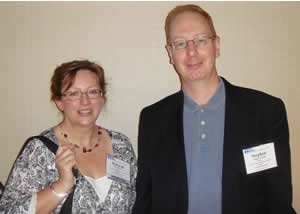GENE THERAPY, GENE EDITING
Further up-to-date information on the UK Gene Therapy Consortium website (www.cfgenetherapy.org.uk)
Also for detailed summary of the history of gene therapy in CF suggest the following article abstracted below – 2018 Cooney AL, McCray PB Jr Sinn PL.Cystic Fibrosis Gene Therapy: Looking Back, Looking Forward. Genes (Basel). 2018 Nov 7;9(11). pii: E538. doi: 10.3390/genes9110538.[PubMed]Free PMC Article
1990 Drumm ML, Pope HA, Cliff WH, Rommens JM, Marvin SA, Tsui L, Collins FS, Frizzell RA, Wilson JM. Correction of cystic fibrosis defect by retrovirus-mediated gene transfer. Cell 1990; 62:1227-1233. [PubMed]

Mitchell Drumm
Retrovirus-mediated gene transfer was used to demonstrate complementation of the CF defect in vitro. Retroviruses were used to transduce a functional cystic fibrosis transmembrane conductance regulator (CFTR) cDNA into a cell line derived from a patient with CF that expressed the chloride transport abnormalities characteristic of cystic fibrosis. Whole-cell patch-clamp performed on three responding clones showed that the anion efflux responses observed were due to cAMP stimulation of Cl conductance.These findings indicated, for the first time, that the introduction of a single copy of the normal CFTR cDNA into CF cells restored the normal cAMP dependent chloride channel function.
Prof. Mitch Drumm after working in Francis Collins laboratory on the identification of the CF gene, is now Associate Professor in the Department of Genetics and the Department of Pediatrics, Case Western Reserve University, Cleveland Ohio.
1993 Hyde SC, Gill DR, Higgins CF, Tresize AEO, MacVinish LJ, Cuthbert AW, Ratcliff R, Evans MJ,

Steven Hyde & Deborah Gill
ColledgeWH. Correction of ion transport defect in cystic fibrosis transgenic mice by gene therapy. Nature 1993; 362:250-255. [PubMed]
Steve Hyde and his wife Deborah Gill and their colleagues in Oxford and Cambridge were the first to demonstrate the use of liposomes as a vector to deliver a CFTR expression plasmid to epithelia of the airway and to alveoli deep in the lungs of CF mice (cf/cf), leading to the correction of the ion conductance defects found in the trachea.
– This was the first correction of the basic defect in CF mice and illustrated the eventual feasibility of gene therapy for the pulmonary aspects of CF in humans. Hopes were high at this stage for the development of gene therapy within a relatively short time. These findings were confirmed in a similar study by Eric Alton and colleagues from Imperial College, London (Alton EW et al. Nat Genet 1993; 5:135-142.[PubMed]).
1993 Zabner J, Couture LA, Gregory RJ, Graham SM, Smith AE, Welsh MJ. Adenovirus-mediated gene transfer transiently corrects the chloride transport defect in nasal epithelia of patients with cystic fibrosis. Cell 1993; 75:207-216. [PubMed]

Joe Zabner
This was the first study to evaluate the potential of direct transfer of cystic fibrosis transmembrane conductance regulator (CFTR) cDNA for the treatment of people with cystic fibrosis. The authors administered an E1-deficient adenovirus, encoding CFTR, to a defined area of nasal airway epithelium of three adults with cystic fibrosis. This treatment corrected the Cl- transport defect that is characteristic of CF-affected epithelia. After treatment, there was a decrease in the abnormally elevated basal transepithelial voltage, and the normal response to a cAMP agonist was restored.
– At the time this treatment was approached with considerable caution as it was a “first” in humans but fortunately there was no evidence of viral replication or virus-associated adverse effects. These were the first nasal studies in humans attempting to correct the CF defect using adenoviral vectors. These data were considered to represent a small step in achieving long-term improvement of CF lung function by gene therapy but, quite understandably, received a great deal of media publicity at the time (figure 1) Other studies of gene therapy followed using viral vectors to the lungs (Crystal et al, 1994 below), and nose (Knowles et al, 1995 below) and using liposomal vectors to the nose (Caplan et al, 1995 below; Porteous et al, 1997 below; Gill et al, 1997 below) to the nose and lungs (Alton et al, 1999) and repeated doses using liposomes to the nose (Hyde et al, 2000 below).
It is salutary that gene therapy for CF was still a considerable way from the clinic even in 2018. Prof. Joseph Zabner led the team who performed this, the first gene transfer in patients with cystic fibrosis.
1994 Crystal RG, McElvaney NG, Rosenfeld MA, Chu CS, Mastrangeli A, Hay JG, Brody SL, Jaffe HA, Eissa NT, Danel C. Administration of an adenovirus containing the human CFTR cDNA to the respiratory tract of individuals with cystic fibrosis. Nat Genet 1994; 8:42-51.[PubMed]

Ron Crystal
This first human gene therapy trial involving the lungs was reported in the press in April 1993. A recombinant adenovirus vector (AdCFTR) containing the normal human CFTR cDNA was administered to the nasal and bronchial epithelium of four individuals with cystic fibrosis. Follow-up at six to 12 months demonstrated no long term adverse effects. Thus, it was considered feasible to use an adenovirus vector to transfer and express the CFTR cDNA in the respiratory epithelium of individuals with CF. It was suggested that correction of the CF phenotype of the airway epithelium might be achieved with this strategy.
– Unfortunately it soon became apparent that viral vectors were not suitable for repeated administration as they caused an increasing antibody response. Ron Crystal was one of the early clinical gene therapy researchers and his group has been involved in many aspects of gene and stem cell therapies.
1995 Knowles MR, Hohneker KW, Zhou Z. Olsen JC, Noah TL, Hu PC, Leigh MW, Engelhardt JF, Edwards LJ, Jones KR, et al. A controlled study of adenoviral-vector-mediated gene transfer in the nasal epithelium of patients with cystic fibrosis. N Eng J Med 1995; 333:823-831. [PubMed]
An adenoviral vector containing the normal CFTR complementary DNA in increasing doses was administered to the nasal epithelium of 12 patients with CF with no obvious beneficial effect. The authors concluded that in patients with CF, adenoviral-vector-mediated transfer of the CFTR gene did not correct functional defects in nasal epithelium, and local inflammatory responses limited the dose of adenovirus that could be administered.
– Another disappointing early gene therapy trial this time from North Carolina using a viral vector. So enthusiasm for viral vectors gradually waned as it became apparent that a significant level of antibodies developed, reducing the potential for their repeated administration.
1995 Caplen NJ, Alton EWFW, Middleton PG, Dorin JR, Stevenson BJ, Gao X, Durham SR, Jeffrey K, Hodson ME, Coutelle C, Huang L, Porteous DJ, Williamson R, Geddes DM. Liposome mediated CFTR gene transfer to the nasal epithelium of patients with cystic fibrosis. Nat Med 1995; 1:39-46. [PubMed]
The first UK nasal gene therapy study using liposomal vectors from the Royal Brompton in London with the cooperation of other centres. A double blind placebo controlled trial in nine CF subjects receiving cationic liposome complexed with complementary DNA encoding the CF transmembrane conductance regulator and six CF subjects receiving only the liposome applied to their nasal epithelium. There were no adverse effects. A partial restoration of the deficit between CF and non-CF subjects of some 20% was seen. Plasmid DNA and Transgene derived RNA were detected in the majority of subjects. The authors concluded that the efficiency and duration would have to improve to achieve meaningful therapeutic benefit.
– Many of the contributors to this first UK gene therapy study from London and Edinburgh led by Eric Alton would eventually form the UK Gene Therapy Consortium which from 2000 would be the main research focus of the UK CF Trust.
1997 Porteous DJ, Dorin R, McLachlan G, Davidson-Smith H, Davidson H, Stevenson BJ, Carothers AD, Wallace WA, Moralee S, Hoenes C, Kallmeyer G, Michaelis U, Naujoks K, Ho LP, Samways JM, Imrie M, Greening AP, Innes JA. Evidence for safety and efficacy of DOTAP cationic liposome mediated CFTR gene transfer to the nasal epithelium of patients with cystic fibrosis. Gene Ther 1997; 4:210-18. [PubMed]

David Porteous
One of the major UK gene therapy studies from Edinburgh. Prof. David Porteous’s group tested the safety and efficacy of gene delivery to the nasal epithelium of CF patients using pCMV-CFTR-DOTAP cationic liposome complex. A single dose of 400 micrograms pCMV-CFTR: 2.4 mg DOTAP was administered in a randomised, double-blinded fashion to the nasal epithelium of eight CF patients, with a further eight receiving buffer only. Transgene DNA was detected in seven of the eight treated patients up to 28 days after treatment and vector derived CFTR mRNA in two of the seven patients at +3 and +7 days. Transepithelial ion transport was assayed before and after treatment by nasal potential difference during drug perfusion and by SPQ fluorescence halide ion conductance. Partial, sustained correction of CFTR-related functional changes toward normal values were detected in two of the eight treated patients. The authors concluded that results justified further studies with pCMV-CFTR-DOTAP aimed at treating CF lung disease.
– This was the second UK study of gene therapy by the Edinburgh group led by David Porteous who later would be one of the three principal researchers in the UK Gene Therapy Consortium when it was formed in 2000.
1997 Gill DR, Southern KW, Mofford KA, Seddon T, Huang L, Sorgi F, Thomson A, MacVinish LJ, Ratcliff R, Bilton D, Littlewood JM, Middleton PG, Colledge WH, Cuthbert AW, Evans MJ, Higgins CF, Hyde SC. A placebo-controlled study of liposome-mediated gene transfer to the nasal epithelium of patients with cystic fibrosis. Gene Ther 1997; 4:199-209. [PubMed]

Kevin Southern
From the Oxford Group and many other UK collaborators, a double-blinded, placebo-controlled, clinical study of the transfer of the CFTR cDNA to the nasal epithelium of 12 CF patients coordinated by Dr Kevin Southern. Cationic liposomes complexed with plasmid containing the human CFTR cDNA were administered to eight patients, whilst four patients received placebo. Biopsies of the nasal epithelium taken seven days after dosing were normal. No significant changes in the clinical parameters were observed. Functional expression of CFTR assessed by in vivo nasal potential difference measurements showed transient correction of the CF chloride transport abnormality in two patients. Fluorescence microscopy demonstrated CFTR function ex vivo in cells from nasal brushings. In total, some evidence of functional CFTR gene transfer was obtained in six out of the eight treated patients.
– This gene therapy study was led by the Oxford Group who would be the third member group in the UK Gene Therapy Consortium which would be formed in 2000. These results provided further proof of concept for liposome-mediated CF gene transfer which would be the vector ultimately chosen by the Consortium for further development to use in their clinical trials which eventually started in 2009.
1999 Alton EW, Stern M, Farley R, Jaffe A, Chadwick SL, Phillips J, Davies J, Smith SN, Browning J, Davies MG, Hodson ME, Durham SR, Li D, Jeffery PK, Scallan M, Balfour R, Eastman SJ, Cheng SH, Smith AE, Meeker D, Geddes DM. Cationic lipid-mediated CFTR gene transfer to the lungs and nose of patients with cystic fibrosis: a double-blind placebo-controlled trial. Lancet 1999; 353:947-54.[PubMed]

Eric Alton
The second Brompton gene therapy study and the most important to date, reporting gene therapy both into the nose and also into the lungs showing some correction of the basic defect in both. Eight patients with CF were randomly assigned DNA-lipid complex (active) by nebulisation into the lungs followed 1 week later by administration to the nose. Eight control patients followed the same protocol but with the lipid alone (placebo). Safety was assessed clinically, by radiography, by pulmonary function, by induced sputum, and by histological analysis. Efficacy was assessed by analysis of vector-specific CFTR DNA and mRNA, in-vivo potential difference, epifluorescence assay of chloride efflux, and bacterial adherence. Seven of the eight patients receiving the active complex reported mild influenza-like symptoms that resolved within 36 hours. Six of eight patients in both the active and placebo groups reported mild airway symptoms over a period of 12 hrs following pulmonary administration. No specific treatment was required for either event. Pulmonary administration resulted in a significant (p<0.05) degree of correction of the chloride abnormality in the patients receiving active treatment but not in those on placebo when assessed by in-vivo potential difference (figure 2) and chloride efflux. Bacterial adherence was also reduced. There were no alterations in the sodium transport abnormality. A similar pattern occurred following nasal administration.
– This was the first UK study of gene therapy into the lungs of people with CF using a liposome vector and was the starting point of the UK Gene Therapy Consortium which became the main research project funded by the UK CF Trust in the millennium under the leadership of Professor Eric Alton of Imperial College, London with Prof David Porteous (Edinburgh) and Drs Steve Hyde and Deborah Gill (Oxford). The UK Gene Therapy Consortium’s next pilot trial eventually started in 2009 and a multiple dose trial in 2012.
2000 Hyde SC, Southern KW, Gileadi U, Fitzjohn EM, Mofford KA, Waddell BE, Gooi HC, Goddard CA, Hannavy K, Smyth SE, Egan JJ, Sorgi FL, Huang L, Cuthbert AW, Evans MJ, Colledge WH, Higgins CF, Webb AK, Gill DR. Repeat administration of DNA/liposomes to the nasal epithelium of patients with cystic fibrosis. Gene Ther 2000; 7:1156-65. [PubMed]
A double-blinded study in which two doses of a DNA/liposome formulation were delivered to the nasal epithelium of 10 people with CF; two received placebo. On average, six of the treated subjects showed evidence of CFTR gene transfer after each dose. All subjects who were positive for CFTR function was also positive for plasmid DNA, plasmid-derived mRNA and CFTR protein in the nasal epithelial cells.
– The efficacy measurements suggest that, unlike high doses of recombinant adenoviral vectors, DNA/liposomes can be successfully re-administered without apparent loss of efficacy; this was the first study to show this. However, as in all previous studies, the correction was not of a degree likely to influence the clinical state.
– Steve Hyde and Deborah Gill became the leaders of the Oxford group of the UK Gene Therapy Consortium. The clinical aspects of the study were coordinated by Dr Kevin Southern who later became Professor of Paediatrics in the Liverpool University Department of Paediatrics at the Alder Hey Children’s Hospital.
2000 Yonemitsu Y, Kitson C, Ferrari S, Farley R, Griesenbach U, Judd D, Steel R, Scheid P, Zhu J, Jeffery PK, Kato A, Hasan MK, Nagai Y, Masaki I, Fukumura M, Hasegawa M, Geddes DM, Alton EW. Efficient gene transfer to airway epithelium using recombinant Sendai virus. Nat Biotech 2000; 18:970-973. [PubMed]
These authors developed recombinant Sendai virus (SeV) as a gene transfer agent that produces very efficient transfection throughout the respiratory tract of both mice and ferrets, as well as in freshly obtained human nasal epithelial cells in vitro.
Gene transfer efficiency was considerably greater than with cationic liposomes or adenovirus and even very brief contact time was sufficient to produce this effect and levels of expression were not significantly reduced by airway mucus. The authors suggested that SeV may provide a useful new vector for airway gene transfer.
Noone PG, Hohneker KW, Zhou Z, Johnson LG, Foy C, Gipson C, Jones K, Noah TL, Leigh MW, Schwartzbach C, Efthimiou J, Pearlman R, Boucher RC, Knowles MR. Safety and biological efficacy of a lipid-CFTR complex for gene transfer in the nasal epithelium of adult patients with cystic fibrosis. Mol Ther: J Am Soc Gene Ther 2000; 1:105-114. [PubMed]
The authors tested the safety and efficacy of a cationic liposome [p-ethyl-dimyristoylphosphadityl choline (EDMPC) cholesterol] complexed with an expression plasmid containing hCFTR cDNA in 11 adults with cystic fibrosis.
Although the lipid-DNA complex was safe, it did not produce consistent evidence of gene transfer to the nasal epithelium either by physiologic or molecular measurements.
2001 Aitken ML, Moss RB, Waltz DA, Dovey ME, Tonelli MR. McNamara SC, Gibson RL, Ramsey BW, Carter BJ, Reynolds TC. A phase I study of aerosolized administration of tgAAVCF to cystic fibrosis subjects with mild lung disease. Human Gene Therapy 2001; 12:1907-1916.[PubMed]

Moira Aitken
A Phase I, single administration, dose escalation trial was designed and executed to assess safety and delivery of tgAAVCF, an adeno-associated virus vector encoding the human CFTR cDNA, by nebulisation to the lungs of CF subjects. Sequential bronchoscopies were performed to gather analytical samples throughout the study. All 12 subjects completed the study. A clear dose-response relationship was observed in vector gene transfer.
– This study confirmed aerosolized tgAAVCF is safe and widely delivered to the proximal airways of CF subjects by nebulisation. Later a large trial (Moss et al, 2007 below) confirmed safety and delivery but had no significant clinical effect.
2004 Konstan MW, Davis PB, Wagener JS, Hilliard KA, Stern RC, Milgram LJ, Kowalczyk TH, Hyatt SL, Fink

Micheal Konstan
TL, Gedeon CR, Oette SM, Payne JM, Muhammad O, Ziady AG, Moen RC, Cooper MJ. Compacted DNA nanoparticles administered to the nasal mucosa of cystic fibrosis subjects are safe and demonstrate partial to complete cystic fibrosis transmembrane regulator reconstitution. Hum Gene Ther 2004; 15:1255-1269. [PubMed]
The authors showed that compacted DNA nanoparticles can be safely administered to the nares of CF subjects, with evidence of vector gene transfer and partial NPD correction.
2005 Lee TW, Matthews DA, Blair GE. Novel molecular approaches to cystic fibrosis gene therapy. Biochem J 205; 387(Pt 1):1-15. [PubMed]

Tim Lee
Efficient delivery and expression of the therapeutic transgene at levels sufficient to result in phenotypic correction of cystic fibrosis pulmonary disease has proved elusive. There are many reasons for this lack of progress, both macroscopically in terms of airway defence mechanisms and at the molecular level with regard to effective cDNA delivery. This review of approaches to cystic fibrosis gene therapy covers these areas in detail and highlights recent progress in the field. For gene therapy to be effective in patients with cystic fibrosis, the cDNA encoding the cystic fibrosis transmembrane conductance regulator protein must be delivered effectively to the nucleus of the epithelial cells lining the bronchial tree within the lungs. Expression of the transgene must be maintained at adequate levels for the lifetime of the patient, either by repeat dosage of the vector or by targeting airway stem cells. Clinical trials of gene therapy for cystic fibrosis have demonstrated proof of principle, but gene expression has been limited to 30 days at best. Results suggest that viral vectors such as adenovirus and adeno-associated virus are unsuited to repeat dosing, as the immune response reduces the effectiveness of each subsequent dose. Non viral approaches, such as cationic liposomes, appear more suited to repeat dosing, but have been less effective. Current work regarding non-viral gene delivery is now focused on understanding the mechanisms involved in cell entry, endosomal escape and nuclear import of the transgene. There is now increasing evidence to suggest that additional ligands that facilitate endosomal escape or contain a nuclear localization signal may enhance liposome-mediated gene delivery. Much progress in this area has been informed by advances in our understanding of the mechanisms by which viruses deliver their genomes to the nuclei of host cells.
– A useful review of gene therapy up to this time by Tim Lee now the senior paediatrician at the Leeds Regional Paediatric unit.
2007 Moss RB, Milla C, Colombo J, Accurso F, Zeitlin PL, Clancy JP, Spencer LT, Pilewski J, Waltz DA, Dorkin HL, Ferkol T, Pian M, Ramsey B, Carter BJ, Martin DB, Heald AE. Repeated aerosolized AAV-CFTR for treatment of cystic fibrosis: a randomized placebo-controlled phase 2B trial. Human Gene Therapy 2007; 18:726-732. [PubMed]
One hundred and two subjects aged 12 years and older with mild-to-moderate cystic fibrosis (forced expiratory flow in 1 sec [FEV1]:60% predicted) were randomized to two aerosolized doses of 1×10(13) DNase-resistant particles of tgAAVCF (n=51) or matching placebo (n=51) administered 30 days apart. Although tgAAVCF was well tolerated, the study did not meet its primary efficacy end point of statistically significant improvement in FEV1 30 days after initial administration of tgAAVCF compared with placebo.
– Thus repeated doses of aerosolized tgAAVCF were safe and well tolerated, but did not result in significant improvement in lung function over time.
2007 Yu ZY, McKay K, van Asperen P, Zheng M, Fleming J, Ginn SL, Kizana E, Latham M, Feneley MP, Kirkland PD, Rowe PB, Lumbers ER, Alexander IE. Lentivirus vector-mediated gene transfer to the developing bronchiolar airway epithelium in the fetal lamb. J Gene Med 2007; 9:429-439. [PubMed]
Targeting the developing airway epithelium during fetal life offers the prospect of circumventing some of the problems with gene therapy. The authors investigated vesicular stomatitis virus glycoprotein (VSVg)-pseudotyped HIV-1-derived lentivirus vector-mediated gene transfer to the airway epithelium of mid-gestation fetal lambs, both in vitro and in vivo. Even during the early pseudoglandular and canalicular phases of lung development, occurring through mid-gestation, the proximal bronchial airway epithelium was relatively mature and highly resistant to lentivirus-mediated transduction. In contrast, the more distal bronchiolar airway epithelium was relatively permissive for transduction although the absolute levels achieved remained low.
– There had been repeated suggestions that fetal gene therapy would be necessary (Larson et al, 1997; Cohen & Larson, 2006 above) although the work on which these suggestions were based was not repeatable in a careful UK study (Buckley et al, 2008 below). Also it is very unlikely that fetal gene therapy would ever be advisable or indeed approved by the regulatory authorities.
2009 Zhang L, Button B, Gabriel SE, Burkett S, Yan Y, Skiadopoulos MH, Dang YL. Vogel LN, McKay T, Mengos A, Boucher RC, Collins PL, Pickles RJ. CFTR delivery to 25% of surface epithelial cells restores normal rates of mucus transport to human cystic fibrosis airway epithelium. Plos Biology 2009; 7(7):e1000155. [PubMed]
Dysfunction of CFTR in cystic fibrosis (CF) airway epithelium perturbs the normal regulation of ion transport, leading to a reduced volume of airway surface liquid (ASL), mucus dehydration, decreased mucus transport, and mucus plugging of the airways. CFTR is normally expressed in ciliated epithelial cells of the surface and submucosal gland ductal epithelium and submucosal gland acinar cells. Critical questions for the development of gene transfer strategies for CF airway disease are what airway regions require CFTR function and how many epithelial cells require CFTR expression to restore normal ASL volume regulation and mucus transport to CF airway epithelium? The data reported here (reported more fully in the abstract) demonstrate for the first time, to our knowledge, that restoration of normal mucus transport rates in CF HAE was achieved after CFTR delivery to 25% of surface epithelial cells. In vivo experimentation in appropriate models will be required to determine what level of mucus transport will afford clinical benefit to CF patients.
The authors predict that a future goal for corrective gene transfer to the CF human airways in vivo would attempt to target at least 25% of surface epithelial cells to achieve mucus transport rates comparable to those in non-CF airways.
2010 Mitomo K, Griesenbach U, Inoue M, Somerton L, Meng C, Akiba E, Tabata T, Ueda Y, Frankel GM, Farley R, Singh C, Chan M, Munkonge F, Brum A, Xenariou S, Escudero-Garcia S, Hasegawa M, Alton EW. Toward gene therapy for cystic fibrosis using a lentivirus pseudotyped with Sendai virus envelopes. Mol Ther 2010; 18(6):1173-1182. [PubMed]
Gene therapy for cystic fibrosis (CF) is making encouraging progress into clinical trials. However, further improvements in transduction efficiency are desired. To develop a novel gene transfer vector that is improved and truly effective for CF gene therapy, a simian immunodeficiency virus (SIV) was pseudotyped with envelope proteins from Sendai virus (SeV), which is known to efficiently transduce unconditioned airway epithelial cells from the apical side. This novel vector was evaluated in mice in vivo and in vitro directed toward CF gene therapy. Here, we show that (i) we can produce relevant titers of an SIV vector pseudotyped with SeV envelope proteins for in vivo use, (ii) this vector can transduce the respiratory epithelium of the murine nose in vivo at levels that may be relevant for clinical benefit in CF, (iii) this can be achieved in a single formulation, and without the need for preconditioning, (iv) expression can last for 15 months, (v) re administration is feasible, (vi) the vector can transduce human air-liquid interface (ALI) cultures, and (vii) functional CF transmembrane conductance regulator (CFTR) chloride channels can be generated in vitro. Our data suggest that this lentiviral vector may provide a step change in airway transduction efficiency relevant to a clinical programme of gene therapy for CF.
– This vector is under development and investigation by the UK Gene Therapy Consortium in collaboration with DNAVEC Corporation, Tsukuba, Japan. The research was supported in part by the UK Cystic Fibrosis Trust.
2008 Davies LA, Varathalingam A, Painter H, Lawton AE, Sumner-Jones SG, Nunez-Alonso GA, Chan M, Munkonge F, Alton EW, Hyde SC, Gill DR. Adenovirus-mediated in utero expression of CFTR does not improve survival of CFTR knockout mice. Molecular Therapy: the Journal of the American Society of Gene Therapy. 2008; 16:812-818. [PubMed]
In utero gene therapy facilitates vector transduction of rapidly expanding populations of target cells while avoiding immune recognition of the vector. In CF, in utero gene transfer could potentially delay the onset of disease symptoms in childhood and compensate for the role, if any, that CFTR plays in the developing organs.
– Previously published studies have suggested that transient expression of CFTR in utero was sufficient to rescue the fatal intestinal defect in S489X Cftr(tm1Unc)/Cftr(tm1Unc) knockout mice. The authors replicated these studies using an identical CFTR-expressing adenoviral vector and CF mouse strain in sufficiently large numbers to provide robust Kaplan-Meier survival data. Although each step of the procedure was carefully controlled and vector-specific CFTR expression was confirmed in the fetal organs after treatment, there was statistically no significant improvement in the survival of mice treated in utero with AdCFTR, compared with contemporaneous control animals.
2007 Figueredo J, Limberis MP, Wilson JM. Prediction of cellular immune responses against CFTR in patients with cystic fibrosis after gene therapy. Am J Resp Cell Mol 2007; 36:529-533. [PubMed]
Different classes of mutations (class I-VI) of the cystic fibrosis (CF) transmembrane conductance regulator (CFTR) gene are responsible for lung/pancreatic disease. The most common mutation, DeltaF508, is characterized by expression of precursor forms of CFTR but no functional CFTR. Since only 5-10% of normal CFTR function is required to correct the electro physiologic defect across the airway epithelium, gene therapy holds promise for treatment of patients with CF lung disease. However, efficient delivery and transgene expression are not the only parameters that may influence the success of gene therapy. Host-specific immune responses generated against the therapeutic CFTR protein may pose a problem, especially when the coding sequence between the normal CFTR and mutated CFTR differ. This phenomenon is more pertinent to class I mutations in which large fragments of the protein are not expressed. However, T cells directed against epitopes that span sequences containing class II-V mutations are also possible. We used MHC-binding prediction programs to predict the probability of cellular immune responses that may be generated against CFTR in DeltaF508 homozygote patients. Results obtained from running the prediction algorithms yielded a few high-scoring MHC-Class I binders within the specific sequences, suggesting that there is a possibility of the host to mount a cellular immune response against CFTR, even when the difference between therapeutic and host CFTR is a single amino acid (F) at position 508
– Transient inflammatory reactions appear to be a frequent occurrence following the administration of gene therapy to people with CF.
2008 Buckley SM, Waddington SN, Jezzard S, Bergau A, Themis M, MacVinish LJ, Cuthbert AW, Colledge WH, Coutelle C. Intra-amniotic delivery of CFTR-expressing adenovirus does not reverse cystic fibrosis phenotype in inbred CFTR-knockout mice. Mol Ther: J Am Soc Gene Ther 2008; 16:819-824. [PubMed]
Due to its early onset and severe prognosis, CF has been suggested as a candidate disease for in utero gene therapy (Cohen JC, Larson JE. Dev Dynam 2006; 235:2736-2748 [PubMed]). In 1997, a study was published claiming that transient prenatal expression of CF transmembrane conductance regulator (CFTR) from an in utero-injected adenovirus vector could achieve permanent reversal of the CF intestinal pathology in adult CF knockout mice, despite the loss of CFTR transgene expression (Larson JE et al. Lancet 1997; 349:619-620). [PubMed] This would imply that the underlying cause of CF is a prenatal defect for which lifelong cure can be achieved by transient prenatal expression of CFTR.
Despite criticism at the time of Larson’s 1997 publication, no independent verification of this contentious finding has been achieved or published so far. This is obviously vital for the development of future therapeutic strategies as it may determine whether CF gene therapy should be performed prenatally or postnatally. Buckley et al therefore reinvestigated this finding with an identical adenoviral vector and a knockout CF mouse line (Cftr (tmlCam)) with a completely inbred genetic background to eliminate any effects due to genetic variation. After delivery of the CFTR-expressing adenovirus to the fetal mouse, both vector DNA and transgenic CFTR expression were detected in treated animals postpartum but statistically no significant difference in survival was observed between the Cftr(-/-) mice treated with the CFTR-adenovirus and those treated with the control vector.
– So this is an important study from a leading group of UK researchers that refutes the frequent claim of Larson and colleagues that, to be effective, gene therapy must be delivered in utero. The members of the UK Gene Therapy Consortium have always questioned Larson’s findings and in this study these authors have been unable to repeat them. Finally it is very unlikely that most researchers, clinicians and regulatory authorities would approve the use of intrauterine gene therapy even if it were shown to be effective.
A further similar study failed to show improved survival in CFTR knockout mice after in utero adenovirus mediated expression of CFTR (Davies LA et al. Mol Ther 2008; 16)812-818. [PubMed]). Also the subject of fetal gene therapy was reviewed by David AL & Peebles D.( Best Pract Res Clin Obstet Gynaecol 2008; 22:203-218. [PubMed]) who state that “recent developments in the understanding of genetic disease, vector design, and minimally invasive delivery techniques have brought fetal gene therapy closer to clinical practice. However more research needs to be done in before it can be introduced as a therapy”. There is obviously continuing interest in this area by the Prenatal and Gene Therapy Group, EGA Institute for Women’s Health, University College, London. (Mehta V et al. Methods Mol Biol 2012; 891:291-328.[PubMed]).
2008 Rakonczay Z Jr, Hegyi P, Hasegawa M, Inoue M, You J, Iida A, Ignath I, Alton EW, Griesenbach U, Ovari G, Vag J, Da Paula AC, Crawford RM, Varga G, Amaral MD, Mehta A, Lonovics J, Argent BE, Gray MA. CFTR gene transfer to human cystic fibrosis pancreatic duct cells using a Sendai virus vector. J Cell Physiol 2008; 214:442-455. [PubMed]
The aim was to investigate the potential of a recombinant Sendai virus (SeV) vector to introduce normal CFTR into human CF pancreatic duct (CFPAC-1) cells, and to assess the effect of CFTR gene transfer on the key transporters involved in HCO3- transport. Using polarized cultures of homozygous F508del CFPAC-1 cells as a model for the human CF pancreatic ductal epithelium the authors showed that Sendai virus was an efficient gene transfer agent when applied to the apical membrane. The presence of functional CFTR was confirmed using iodide efflux assay. CFTR expression had no effect on cell growth, monolayer integrity, and mRNA levels for key transporters in the duct cell, but did upregulate the activity of apical Cl-/HCO3- and Na+/H+ exchangers. In CFTR-corrected cells, apical Cl-/HCO3- exchange activity was further enhanced by cAMP, a key feature exhibited by normal pancreatic duct cells.
– This paper is abstracted in some detail as most studies of gene therapy refer to the chest whereas this involves the pancreas. The authors’ data shows that SeV vector is a potential CFTR gene transfer agent for human pancreatic duct cells and that expression of CFTR in CF cells is associated with a restoration of both Cl- and HCO3- transport at the apical membrane. It is encouraging that work of this type is in progress by a group expert in this area. It is to be hoped that that this may lead to a “Pancreatic Consortium” as it would be of enormous benefit to patients if their decline of pancreatic function could be arrested, in particular, if there were preservation of the islets of Langerhans so as to avoid diabetes mellitus, which at present is almost inevitable in older adults.
2009 Zhang L, Button B, Gabriel SE, Burkett S, Yan Y, Skiadopoulos MH, Dang YL, Vogel LN, McKay T, Mengos A, Boucher RC, Collins PL, Pickles RJ. CFTR delivery to 25% of surface epithelial cells restores normal rates of mucus transport to human cystic fibrosis airway epithelium. Plos Biology 2009; 7(7):e1000155. [PubMed]
Critical questions for the development of gene transfer strategies for CF airway disease are what airway regions require CFTR function and how many epithelial cells require CFTR expression to restore normal ASL volume regulation and mucus transport to CF airway epithelium?
– The data reported here (reported more fully in the abstract) demonstrate that restoration of normal mucus transport rates in CF was achieved after CFTR delivery to 25% of surface epithelial cells. In vivo experimentation in appropriate models will be required to determine what level of mucus transport will afford clinical benefit to CF patients, but they predict that a future goal for corrective gene transfer to the CF human airways in vivo would attempt to target at least 25% of surface epithelial cells to achieve mucus transport rates comparable to those in non-CF airways.
There has been considerable discussion as to the amount of CFTR activity necessary to signifcantly improve the airways of people with CF. Certainly 50% of normal apears to be adequate as is present in CF carriers. An estimate of 10% has been suggested as providing a signifcant effect if this could be achieved by gene therapy or other means.
2010 Carlon M, Toelen J, Van der Perren A, Vandenberghe LH, Reumers V, Sbragia L, Gijsbers R, Baekelandt V, Himmelreich U, Wilson JM, Deprest J, Debyser Z. Efficient gene transfer into the mouse lung by fetal intratracheal injection of rAAV2/6. 2. Molecular Therapy: J Amer Soc Gene Ther 2010; 18:2130-2138. [PubMed]
Fetal gene therapy is one of the possible new therapeutic strategies for congenital or perinatal diseases with high mortality or morbidity. The authors developed a novel delivery strategy to inject viral vectors directly into the fetal mouse trachea. Histological analysis for beta-galactosidase (beta-gal) revealed 17. 5% of epithelial cells transduced in the conducting airways and 1. 5% in the alveolar cells. Stable gene expression was observed up to 1 month after injection. The authors observe that direct injection of rAAV2/6. 2 in the fetal mouse trachea is superior for transducing the lung and this approach may be useful to evaluate fetal gene therapy for pulmonary diseases such as cystic fibrosis, requiring both substantial numbers of transduced cells as well as prolonged gene expression to obtain a stable phenotypic effect.
– There have been suggestions that fetal gene therapy would be necessary for people with CF (Larson et al, 1997; Cohen & Larson, 2006) although the work on which these suggestions were based was not repeatable in a careful UK study (Buckley et al, 2008). In another study (Yu ZY et al, 2007) the authors investigated vesicular stomatitis virus glycoprotein (VSVg)-pseudotyped HIV-1-derived lentivirus vector-mediated gene transfer to the airway epithelium of mid-gestation fetal lambs, both in vitro and in vivo. Even during the early pseudoglandular and canalicular phases of lung development, occurring through mid-gestation, the proximal bronchial airway epithelium was relatively mature and highly resistant to lentivirus-mediated transduction. In contrast, the more distal bronchiolar airway epithelium was relatively permissive for transduction although the absolute levels achieved remained low.
However, it is very unlikely that fetal gene therapy would ever be advisable or indeed approved at the present time or in the future for CF by the regulatory authorities.
2010 Mitomo K, Griesenbach U, Inoue M, Somerton L, Meng C, Akiba E, Tabata T, Ueda Y, Frankel GM, Farley R, Singh C, Chan M, Munkonge F, Brum A, Xenariou S, Escudero-Garcia S, Hasegawa M, Alton EW. Toward gene therapy for cystic fibrosis using a lentivirus pseudotyped with Sendai virus envelopes. Mol Ther 2010; 18:1173-1182.[PubMed] Free PMC article.
Gene therapy for cystic fibrosis (CF) is making encouraging progress into clinical trials. However, further improvements in transduction efficiency are desired. To develop a novel gene transfer vector that is improved and truly effective for CF gene therapy, a simian immunodeficiency virus (SIV) was pseudotyped with envelope proteins from Sendai virus (SeV), which is known to efficiently transduce unconditioned airway epithelial cells from the apical side. This novel vector was evaluated in mice in vivo and in vitro directed toward CF gene therapy.
2010 Carlon M, Toelen J, Van der Perren A, Vandenberghe LH, Reumers V, Sbragia L, Gijsbers R, Baekelandt V, Himmelreich U, Wilson JM, Deprest J, Debyser Z. Efficient gene transfer into the mouse lung by fetal intratracheal injection of rAAV2/6. 2. Molecular Therapy: J Amer Soc Gene Ther 2010; 18:2130-2138. [PubMed] Fetal gene therapy is one of the possible new therapeutic strategies for congenital or perinatal diseases with high mortality or morbidity. The authors developed a novel delivery strategy to inject viral vectors directly into the fetal mouse trachea. Histological analysis for beta-galactosidase (beta-gal) revealed 17. 5% of epithelial cells transduced in the conducting airways and 1. 5% in the alveolar cells. Stable gene expression was observed up to 1 month after injection. The authors observe that direct injection of rAAV2/6. 2 in the fetal mouse trachea is superior for transducing the lung and this approach may be useful to evaluate fetal gene therapy for pulmonary diseases such as cystic fibrosis, requiring both substantial numbers of transduced cells as well as prolonged gene expression to obtain a stable phenotypic effect.
– There have been suggestions that fetal gene therapy would be necessary for people with CF (Larson et al, 1997; Cohen & Larson, 2006) although the work on which these suggestions were based was not repeatable in a careful UK study (Buckley et al, 2008). In another study (Yu ZY et al, 2007) the authors investigated vesicular stomatitis virus glycoprotein (VSVg)-pseudotyped HIV-1-derived lentivirus vector-mediated gene transfer to the airway epithelium of mid-gestation fetal lambs, both in vitro and in vivo. Even during the early pseudoglandular and canalicular phases of lung development, occurring through mid-gestation, the proximal bronchial airway epithelium was relatively mature and highly resistant to lentivirus-mediated transduction. In contrast, the more distal bronchiolar airway epithelium was relatively permissive for transduction although the absolute levels achieved remained low.
However, it is very unlikely that fetal gene therapy would ever be advisable or indeed approved at the present time or in the future for CF by the regulatory authorities.
2011 McLachlan G, Davidson H, Holder E, Davies LA, Pringle IA, Sumner-Jones SG, Baker A, Tennant P, Gordon C, Vrettou C, Blundell R, Hyndman L, Stevenson B, Wilson A, Doherty A. Shaw DJ, Coles RL, Painter H, Cheng SH, Scheule RK, Davies JC, Innes JA, Hyde SC, Griesenbach U, Alton EW, Boyd AC, Porteous DJ, Gill DR, Collie DD. Pre-clinical evaluation of three non-viral gene transfer agents for cystic fibrosis after aerosol delivery to the ovine lung. Gene Ther 2011; 18:996-1005. [PubMed]
The UK Gene Therapy Consortium report the use of a large animal model to assess three non-viral gene transfer agents (GTAs): 25 kDa-branched polyethyleneimine (PEI), the cationic liposome (GL67A) and compacted DNA nanoparticle formulated with polyethylene glycol-substituted lysine 30-mer. GTAs complexed with plasmids expressing human cystic fibrosis transmembrane conductance regulator (CFTR) complementary DNA were administered to the sheep lung (n=8 per group) by aerosol. All GTAs gave evidence of gene transfer and expression 1 day after treatment. Vector-derived mRNA was expressed in lung tissues, including epithelial cell-enriched bronchial brushing samples, with median group values reaching 1-10% of endogenous CFTR mRNA levels. GL67A gave the highest levels of expression. Human CFTR protein was detected in small airway epithelial cells in some animals treated with GL67A (two out of eight) and PEI (one out of eight). Bronchoalveolar lavage neutrophilia, lung histology and elevated serum haptoglobin levels indicated that gene delivery was associated with mild local and systemic inflammation. Ther authors’ conclusion was that GL67A was the best non-viral GTA currently available for aerosol delivery to the sheep lung, led to the selection of GL67A as their lead GTA for clinical trials of gene therapy in CF patients.
– The UK Gene Therapy Consortium’s trial of gene therapy is started in 2012 and the present study confirmed their choice of GL67A as the most suitable gene transfer agent to be used in the trial.. The multidose trial will represent the culmination of over 10 years work on the part of the members of the GTC in London, Oxford and Edinburgh. The presence of mild inflammation was also noticed in the first CF patients treated in the pilot study (Davies JC et al. Safety and expression of a single dose of lipid-mediated CFTR gene therapy to the upper and lower airways of patients with CF. Pediatr Pulmonol 2011; Suppl 34: Abstract 198. Page 281).
2011 Ogilvie V, Passmore M, Hyndman L, Jones L, Stevenson B, Wilson A, Davidson H, Kitchen RR, Gray RD, Shah P, Alton EW, Davies JC, Porteous DJ, Boyd AC. Differential global gene expression in cystic fibrosis nasal and bronchial epithelium. Genomics 2011: 98:327-336. [PubMed]
Respiratory epithelium is the target of therapies, such as gene therapy, for cystic fibrosis (CF) lung disease. To determine the usefulness of the nasal epithelium as a pre-screen for lung-directed therapies, the authors profiled gene expression in CF and non-CF nasal and bronchial epithelium samples using Illumina HumanRef-8 Expression BeadChips. 863 genes were differentially expressed between CF and non-CF bronchial epithelium but only 15 were differentially expressed between CF and non-CF nasal epithelium (>=1.5-fold, P<=0.05). The most enriched pathway in CF bronchial epithelium was inflammatory response, whereas in CF nasal epithelium it was amino acid metabolism. We also compared nasal and bronchial epithelium in each group and identified differential expression of cellular movement genes in CF patients and cellular growth genes in non-CF subjects. The authors concluded that CF and non-CF nasal and bronchial epithelium are transcriptionally distinct and CF nasal epithelium is not a good surrogate for the lung respiratory epithelium.
– More work from the UK Gene Therapy Consortium looking at specific practical issues as applied to gene therapy and the monitoring of such therapy. The publications of this type from the UK GTC over the past 10 years are numerous (see details on their website www.cfgenetherapy.org.uk) and have paved the way for the forthcoming UK multidose gene therapy trial which started in 2012 – this trial is a world first and the culmination of over ten years research since the Consortium was formed.
2012 Griesenbach U. Alton EW. Progress in gene and cell therapy for cystic fibrosis lung disease. Curr Pharm Design 2012; 18:642-62, 2012. [PubMed]

Uta Griesenbach
Although the development of gene therapy for cystic fibrosis (CF) was high priority for many groups in academia and industry in the first 10 to 15 years after cloning the gene, more recently active research into CF gene therapy is only being performed by a small number of committed, mainly academic, groups. However, despite the waning enthusiasm, which is largely due to the realisation that gene transfer into lungs is more difficult than originally thought and the fact that meaningful clinical trials are expensive and difficult to perform, gene therapy continues to hold promise for the treatment of CF lung disease. Problems related to repeat administration of adenovirus and adeno-associated virus-based vectors led to a focus on non-viral vectors in clinical trials. The UK CF Gene Therapy Consortium is currently running the only active gene therapy programme, aimed at assessing if repeated administration of a non-viral gene transfer agent can improve CF lung disease. However, the recent suggestion that lentiviral vectors may be able to evade the immune system and, thereby, allow for repeat administration and long lasting expression opens new doors for the use of viral vectors in the context of CF gene therapy. In addition, early pre-clinical studies have recently been initiated to address cell therapy-based approaches for CF. This involves systemic and topical administration of a variety of stem/progenitor cells, as well as first attempts as producing a tissue-engineered lung. Recent studies in viral and non-viral vector developments, as well as cell therapy will be discussed and an update on clinical gene therapy studies will be provided here.
– An up to date review of the present situation regarding gene therapy by Uta Griesenbach and Eric Alton of the UK Gene Therapy Consortium who are about to embark on a multidose trial of gene therapy in 2012.
2013 Alton EW. Baker A. Baker E. Boyd AC. Cheng SH. Coles RL. Collie DD. Davidson H. Davies JC. Gill DR. Gordon C. Griesenbach U. Higgins T. Hyde SC. Innes JA. McCormick D. McGovern M. McLachlan G. Porteous DJ. Pringle I. Scheule RK. Shaw DJ. Smith S. Sumner-Jones SG. Tennant P. Vrettou C. The safety profile of a cationic lipid-mediated cystic fibrosis gene transfer agent following repeated monthly aerosol administration to sheep. Biomaterials 2013; 34:10267-77. [PubMed]
The UK CF Gene Therapy Consortium is currently evaluating long-term repeated delivery of pGM169 complexed with the cationic lipid GL67A in a large Multidose Trial. This regulatory-compliant evaluation of aerosol administration of nine doses of pGM169/GL67A at monthly intervals, to the sheep lung, was performed in preparation for the Multidose Trial. All sheep tolerated treatment well with no adverse effects on haematology, serum chemistry, lung function or histopathology. Acute responses were observed in relation to bronchoalveolar cellularity comprising increased neutrophils and macrophage numbers 1 day post-delivery but these increases were transient and returned to baseline. Importantly there was no cumulative inflammatory effect or lung remodelling with successive doses. Molecular analysis confirmed delivery of pGM169 DNA to the airways and pGM169-specific mRNA was detected in bronchial brushing samples at day 1 following doses 1, 5 and 9. In conclusion, nine doses of pGM169/GL67A were well tolerated with no significant evidence of toxicity that would preclude adoption of a similar strategy in CF patients.
– This regulatory compliant evaluation preceded the multi-dose gene therapy trial which started in 2013 and was projected to finish in mid-2014.
2013 Alton EW. Boyd AC. Cheng SH. Cunningham S. Davies JC. Gill DR. Griesenbach U. Higgins T. Hyde SC. Innes JA. Murray GD. Porteous DJ. A randomised, double-blind, placebo-controlled phase IIB clinical trial of repeated application of gene therapy in patients with cystic fibrosis. Thorax 2013; 68:1075-7.[PubMed]
The members of the UK Cystic Fibrosis Gene Therapy Consortium have been working towards clinical gene therapy for patients with cystic fibrosis for over 10 years. They have recently embarked on a large, multi-dose clinical trial of a non-viral, liposome-based formulation powered for the first time to detect clinical benefit. The article describes the details of the protocol.
– By early 2014 the gene therapy trial mentioned was well advanced and completed in 2014. The lack of serious side effects shown in the sheep study was confirmed in the trial with the CF patients who tolerated the treatment without serious side effects.
2013 Horsley AR. Davies JC. Gray RD. Macleod KA. Donovan J. Aziz ZA. Bell NJ. Rainer M. Mt-Isa S. Voase N. Dewar MH. Saunders C. Gibson JS. Parra-Leiton J. Larsen MD. Jeswiet S. Soussi S. Bakar Y. Meister MG. Tyler P. Doherty A. Hansell DM. Ashby D. Hyde SC. Gill DR. Greening AP. Porteous DJ. Innes JA. Boyd AC. Griesenbach U. Cunningham S. Alton EW. Changes in physiological, functional and structural markers of cystic fibrosis lung disease with treatment of a pulmonary exacerbation. Thorax 2013; 68:532-9. [PubMed]
A study by members of the UK Gene Therapy Consortium to evaluate a range of conventional and novel biomarkers of CF lung disease in a multicentre setting as a contributing study in selecting outcome assays for their 2013-2014 clinical trial of CFTR gene therapy. Measurements were performed at commencement and immediately after a course of intravenous antibiotics. Disease activity was assessed using 46 assays across five key domains: symptoms, lung physiology, structural changes on CT, pulmonary and systemic inflammatory markers.
Statistically significant improvements were seen in forced expiratory volume in 1 s (p<0.001, n=32), lung clearance index (p<0.01, n=32), symptoms (p<0.0001, n=37), CT scores for airway wall thickness (p<0.01, n=31), air trapping (p<0.01, n=30) and large mucus plugs (p=0.0001, n=31), serum C-reactive protein (p<0.0001, n=34), serum interleukin-6 (p<0.0001, n=33) and serum calprotectin (p<0.0001, n=31).
The authors identified the key biomarkers of inflammation, imaging and physiology that alter alongside symptomatic improvement following treatment of an acute CF exacerbation. These data, in parallel with their study of biomarkers in patients with stable CF, provide important guidance in choosing optimal biomarkers for novel therapies. Further, they highlight that such acute therapy predominantly improves large airway parameters and systemic inflammation, but has less effect on airway inflammation.
– The UK Gene Therapy Consortium commenced their multi-dose major gene therapy trial in June 2012 (Alton EW et al. Pediatr Pulmonol 2013; Suppl 36: Poster 245). This study helped to determine the parameters which would be used in the trial. The primary outcome chosen was the FEV1 and secondary outcomes the lung clearance index, CT changes and CFQ questionnaire. The trial will be completed around June 2014.
– The Cystic Fibrosis Trust provided substantial funding for these studies and many other studies during the decade leading up to the gene therapy trial but was unable to fund the trial itself for which the GTC, due to the excellence of their work, were successful in achieving funding from the Medical Research Council Efficacy and Mechanism Evaluation (EME) funding.
2013 CaoH, Machuca TN, Yeung JC, Wu J, Du C, Hashimoto K, Linacre V, Coates AL, leung K, Wang J, Yeger H, Cutz E, Liu M, Keshavjee S, Hu J. Efficient gene delivery to pig airway epithelia and submucosal glands using helper-dependent adenoviral vectors. Mol Ther Nucleic Acids 2013; 2:e127. doi: 10.1038/mtna.2013.55.[PubMed]
Airway gene delivery is a promising strategy to treat patients with life-threatening lung diseases such as cystic fibrosis (CF). However, this strategy has to be evaluated in large animal preclinical studies in order to translate it to human applications. Because of anatomic and physiological similarities between the human and pig lungs, they utilized pig as a large animal model to examine the safety and efficiency of airway gene delivery with helper-dependent adenoviral vectors.
Helper-dependent vectors carrying human CFTR or reporter gene LacZ were aerosolized intratracheally into pigs under bronchoscopic guidance. They found that the LacZ reporter and hCFTR transgene products were efficiently expressed in lung airway epithelial cells. The transgene vectors with this delivery can also reach to submucosal glands. Moreover, the hCFTR transgene protein localized to the apical membrane of both ciliated and nonciliated epithelial cells, mirroring the location of wild-type CF transmembrane conductance regulator (CFTR).
Aerosol delivery procedure was well tolerated by pigs without showing systemic toxicity based on the limited number of pigs tested. These results provide important insights into developing clinical strategies for human CF lung gene therapy
2013 Stoltz DA, Rokhlina T, Ernst SE, Pezzulo AA, Ostedgaard LS, Karp PH, Samuel MS, Reznikov LR, Rector MV, Gansemer ND, Bouzek DC, Alaiwa MH, Hoegger MJ, Ludwig PS, Taft PJ, Wallen TJ, Wohlford-Lenane C, McMenimen JD, Chen JH, Bogan KL, Adam RJ, Hornick EE, Nelson GA 4th, Hoffman EA, Chang EH, Zabner J, McCray PB Jr, Prather RS, Meyerholz DK, Welsh MJ. Intestinal CFTR expression alleviates meconium ileus in cystic fibrosis pigs. J Clin Invest. 2013 ;123:2685-93.[PubMed]
Cystic fibrosis (CF) pigs develop disease with features remarkably similar to those in people with CF, including exocrine pancreatic destruction, focal biliary cirrhosis, micro-gallbladder, vas deferens loss, airway disease, and meconium ileus. Whereas meconium ileus occurs in 15% of babies with CF, the penetrance is 100% in newborn CF pigs. The authors hypothesized that transgenic expression of porcine CF transmembrane conductance regulator (pCFTR) cDNA under control of the intestinal fatty acid-binding protein (iFABP) promoter would alleviate the meconium ileus. They produced 5 CFTR-/-;TgFABP>pCFTR lines. In 3 lines, intestinal expression of CFTR at least partially restored CFTR-mediated anion transport and improved the intestinal phenotype. In contrast, these pigs still had pancreatic destruction, liver disease, and reduced weight gain, and within weeks of birth, they developed sinus and lung disease, the severity of which varied over time.
The authors consider these data indicate that expressing CFTR in intestine without pancreatic or hepatic correction is sufficient to rescue meconium ileus. Comparing CFTR expression in different lines revealed that approximately 20% of wild-type CFTR mRNA largely prevented meconium ileus. The suggest this model may be of value for understanding CF pathophysiology and testing new preventions and therapies.
2014 Griffin MA, Restrepo MS, Abu-El-Haija M, Wallen T, Buchanan E, Rokhlina T, Chen YH, McCray bPBJr, Davidson BL, Divekar A, Uc A. Novel gene delivery method transduces porcine pancreatic duct epithelial cells. Gene Ther. 2014; 21(2):123-30. [PubMed]
Gene therapy offers the possibility to treat pancreatic disease in cystic fibrosis (CF), caused by mutations in the CF transmembrane conductance regulator (CFTR) gene; however, gene transfer to the pancreas is untested in humans. The pancreatic disease phenotype is very similar between humans and pigs with CF; thus, CF pigs create an excellent opportunity to study gene transfer to the pancreas. There are no studies showing efficient transduction of pig pancreas with gene-transfer vectors.
The authors’ objective was to develop a safe and efficient method to transduce wild-type (WT) porcine pancreatic ducts that express CFTR. They catheterized the umbilical artery of WT newborn pigs and delivered an adeno-associated virus serotype 9 vector expressing green-fluorescent protein (AAV9CMV.sceGFP) or vehicle to the celiac artery, the vessel that supplies major branches to the pancreas. This technique resulted in stable and dose-dependent transduction of pancreatic duct epithelial cells that expressed CFTR. Intravenous (IV) injection of AAV9CMV.sceGFP did not transduce the pancreas.
Their technique offers an opportunity to deliver the CFTR gene to the pancreas of CF pigs. The celiac artery can be accessed via the umbilical artery in newborns and via the femoral artery at older ages-delivery approaches that can be translated to humans.
Although modern pancreatic enzyme replacement therapy is relative effective, at present there is no way of preventing the relentless destruction of the pancreas leading to CF related diabetes. The development of approaches such as described here is welcome.
2015 Alton EW, Armstrong DK, Ashby D, Bayfield KJ3, Bilton D, Buchan R, et al, UK Cystic Fibrosis Gene Therapy Consortium. Repeated nebulisation of non-viral CFTR gene therapy in patients with cystic fibrosis: a randomised, double-blind, placebo-controlled, phase 2b trial. Lancet Respir Med. 2015 Jul 3. pii: S2213-2600(15)00245-3. doi: 10.1016/S2213-2600(15)00245-3. [Epub ahead of print] [free text available] [PubMed]
Lung delivery of plasmid DNA encoding the CFTR gene complexed with a cationic liposome is a potential treatment option for patients with cystic fibrosis. The authors aimed to assess the efficacy of non-viral CFTR gene therapy in patients with cystic fibrosis.
A randomised, double-blind, placebo-controlled, phase 2b trial in two cystic fibrosis centres with patients recruited from 18 sites in the UK. Patients (aged ≥12 years) with a forced expiratory volume in 1 s (FEV1) of 50-90% predicted and any combination of CFTR mutations, were randomly assigned, via a computer-based randomisation system, to receive 5 mL of either nebulised pGM169/GL67A gene-liposome complex or 0·9% saline (placebo) every 28 days (plus or minus 5 days) for 1 year. Randomisation was stratified by % predicted FEV1 (<70 vs ≥70%), age (<18 vs ≥18 years), inclusion in the mechanistic substudy, and dosing site (London or Edinburgh). Participants and investigators were masked to treatment allocation. The primary endpoint was the relative change in % predicted FEV1. The primary analysis was per protocol.
Between June 12, 2012, and June 24, 2013, patients were randomly assigned, 140 patients to receive placebo (n=62) or pGM169/GL67A (n=78), of whom 116 (83%) patients comprised the per-protocol population.
There was significant, albeit modest, treatment effect in the pGM169/GL67A group versus placebo at 12 months’ follow-up (3·7%, 95% CI 0·1-7·3; p=0·046). This outcome was associated with a stabilisation of lung function in the pGM169/GL67A group compared with a decline in the placebo group. There was no significant difference noted in treatment-attributable adverse events between groups.
Monthly application of the pGM169/GL67A gene therapy formulation was associated with a significant, albeit modest, benefit in FEV1 compared with placebo at 1 year, indicating a stabilisation of lung function in the treatment group. Further improvements in efficacy and consistency of response to the current formulation are needed before gene therapy is suitable for clinical care; however, our findings should also encourage the rapid introduction of more potent gene transfer vectors into early phase trials.
– Commentary by Scott Bell on this Alton et al publication
2015 Bell SC. A new phase of CFTR treatment for cystic fibrosis? Lancet Respir Med 2015; 3(9):662-663. no abstract [PubMed]

Scott Bell
After mention of the developments in CFTR treatments Scott Bell reviews in some detail the UK Gene Therapy Consortium’s randomised, double-blind, placebo-controlled, phase 2b study of multi-dose nebulised gene–liposome complex (pGM169/GL67A) in patients with cystic fibrosis (FEV 1 50–90% predicted) and any combination of CFTR mutation (Alton EWFW et al, 2015). Therapy with pGM169/GL67A was well tolerated, with no excess treatment-associated adverse effects. Nasal and lower airway gene transfer analyses, showed modest concentrations of pGM169 plasmid DNA. Of the roughly one in five participants who had an improvement in FEV 1 of more than 5%, 70% had received the gene–liposome complex. Another notable finding was that patients with more severe lung disease (FEV 1 49·6–69·2% predicted) tended to have a greater treatment effect (6·4%) than those with milder lung disease (FEV 1 69·6–89·9% predicted; treatment effect 0·2%; p=0·065).
Commenting on the use of physiological saline as placebo – Scott Bell suggested future trials should included a CFTR depleted plasma liposome placebo also effect on quality of life and pulmonary exacerbations (not an end point in this trial). He noted the increasing awareness of the complexity of the interactions between the CFTR protein and complex intracellular protein networks and suggested an even broader understanding of the cellular biology of CFTR would be necessary for successful correction of the numerous CFTR muta
– The UK Gene Therapy Consortium are currently (2018) evaluating the use of a viral vector.
2016 Abou Alaiwa MH, Shah VS, Bouzek DC, Stroik MR, Powers LS, Gansemer ND, Meyerholz DK, Welsh MJ, Stoltz DA, Sinn PL, McCray PB Jr. Lentiviral-mediated phenotypic correction of cystic fibrosis pigs. JCI Insight. 2016 Sep 8;1(14). pii: e88730.1. [PubMed]
Regardless of the disease-causing CF mutation, gene therapy is a strategy to restore anion transport to airway epithelia. Indeed, viral vector-delivered CFTR can complement the anion channel defect. In this proof-of-principle study, functional in vivo CFTR channel activity was restored in the airways of CF pigs using a feline immunodeficiency virus-based (FIV-based) lentiviral vector pseudotyped with the GP64 envelope.Three newborn CF pigs received aerosolized FIV-CFTR to the nose and lung. Two weeks after viral vector delivery, epithelial tissues were analysed for functional correction. In freshly excised tracheal and bronchus tissues and cultured ethmoid sinus cells, there was a significant increase in transepithelial cAMP-stimulated current, evidence of functional CFTR. In addition, we observed increases in tracheal airway surface liquid pH and bacterial killing in CFTR vector-treated animals.
– Together, these data provide the first evidence that lentiviral delivery of CFTR can partially correct the anion channel defect in a large-animal CF model and validate a translational strategy to treat or prevent CF lung disease.
2016 Alton EWFW, Armstrong DK, Ashby D, Bayfield KJ, Bilton D, Bloomfield EV, et al. on behalf of the UK Cystic Fibrosis Gene Therapy Consortium.A randomised, double-blind, placebo-controlled trial of repeated nebulisation of non-viral cystic fibrosis transmembrane conductance regulator (CFTR) gene therapy in patients with cystic fibrosis.Southampton (UK): NIHR Journals Library; 2016 Jul

Eric Alton
To determine clinical efficacy of the formulation delivered to the airways over a period of 1 year in patients with CF. This was a randomised, double-blind, placebo-controlled Phase IIb trial of the CFTRgene–liposome complex pGM169/GL67A. Randomisation was performed via InForm™ version 4.6 (Phase Forward Incorporated, Oracle, CA, USA) and was 1 : 1, except for patients in the mechanistic subgroups (2 : 1). Allocation was blinded by masking nebuliser chambers. Data were collected in the clinical and scientific sites and entered onto a trial-specific InForm, version 4.6 database. Patients with CF aged ≥ 12 years with forced expiratory volume in the first second (FEV1) between 50% and 90% predicted and any combination of CFTR mutations. The per-protocol group (≥ 9 doses) consisted of 54 patients receiving placebo (62 randomised) and 62 patients receiving gene therapy (78 randomised). Subjects received 5 ml of nebulised pGM169/G67A (active) or 0.9% saline (placebo) at 28 (±5)-day intervals over 1 year. The primary end point was the relative change in percentage predicted FEV1 over the 12-month period. A number of secondary clinical outcomes were assessed alongside safety measures: other spirometric values; lung clearance index (LCI) assessed by multibreath washout; structural disease on computed tomography (CT) scan; the Cystic Fibrosis Questionnaire – Revised (CFQ-R), a validated quality-of-life questionnaire; exercise capacity and monitoring; systemic and sputum inflammatory markers; and adverse events (AEs). A mechanistic study was performed in a subgroup in whom transgene deoxyribonucleic acid (DNA) and messenger ribonucleic acid (mRNA) was measured alongside nasal and lower airway potential difference.
RESULTS: There was a significant (p=0.046) treatment effect (TE) of 3.7% [95% confidence interval (CI) 0.1% to 7.3%] in the primary end point at 12 months and in secondary end points, including forced vital capacity (FVC) (p = 0.031) and CT gas trapping (p=0.048). Other outcomes, although not reaching statistical significance, favoured active treatment. Effects were noted by 1 month and were irrespective of sex, age or CFTR mutation class. Subjects with a more severe baseline FEV1 had a FEV1 TE of 6.4% (95% CI 0.8% to 12.1%) and greater changes in many other secondary outcomes. However, the more mildly affected group also demonstrated benefits, particularly in small airway disease markers such as LCI. The active group showed a significantly (p=0.032) greater bronchial chloride secretory response. No difference in treatment-attributable AEs was seen between the placebo and active groups.
CONCLUSIONS: Monthly application of the pGM169/GL67A gene therapy formulation was associated with an improvement in lung function, other clinically relevant parameters and bronchial CFTR function, compared with placebo.
Although encouraging, the improvement in FEV1 was modest and was not accompanied by detectable improvement in patients’ quality of life. Future work will focus on attempts to increase efficacy by increasing dose or frequency, the co-administration of a CFTR potentiator, or the use of modified viral vectors capable of repeated administration.
The further report of the UK Gene Therapy Consortium Trial in Lancet Respiratory Medicine, The, 2015-09-01, Volume 3, Issue 9, Pages 684-691. Eric W F W Alton Prof, David K Armstrong MB ChB, Deborah Ashby Prof, Katie J Bayfield BSc, Diana Bilton Prof, Emily V Bloomfield BSc et al. Repeated nebulisation of non-viral CFTR gene therapy in patients with cystic fibrosis: a randomised, double-blind, placebo-controlled, phase 2b trial. Lancet Respiratory Medicine, The, 2015-09-01, Volume 3, Issue 9, Pages 684-691
Professor Eric Alton (figure 2) is the leader of the UK Gene Therapy Consortium at Imperial College London.
2016 Alton EW, Beekman JM, Boyd AC, Brand J, Carlon MS, Connolly MM, et al. Preparation for a first-in-man lentivirus trial in patients with cystic fibrosis. Thorax. 2016 Nov 16. pii: thoraxjnl-2016-208406. doi: 10.1136/thoraxjnl-2016-208406. [Epub ahead of print] [PubMed]
The authors have recently shown that non-viral gene therapy can stabilise the decline of lung function in patients with cystic fibrosis (CF). However, the effect was modest, and more potent gene transfer agents are still required. Fuson protein (F)/Hemagglutinin/Neuraminidase protein (HN)-pseudotyped lentiviral vectors are more efficient for lung gene transfer than non-viral vectors in preclinical models. In preparation for a first-in-man CF trial using the lentiviral vector, they have undertaken key translational preclinical studies. Regulatory-compliant vectors carrying a range of promoter/enhancer elements were assessed in mice and human air-liquid interface (ALI) cultures to select the lead candidate; cystic fibrosis transmembrane conductance receptor (CFTR) expression and function were assessed in CF models using this lead candidate vector. Toxicity was assessed and ‘benchmarked’ against the leading non-viral formulation recently used in a Phase IIb clinical trial. Integration site profiles were mapped and transduction efficiency determined to inform clinical trial dose-ranging. The impact of pre-existing and acquired immunity against the vector and vector stability in several clinically relevant delivery devices was assessed. A hybrid promoter hybrid cytosine guanine dinucleotide (CpG)- free CMV enhancer/elongation factor 1 alpha promoter (hCEF) consisting of the elongation factor 1αpromoter and the cytomegalovirus enhancer was most efficacious in both murine lungs and human ALI cultures (both at least 2-log orders above background).
The efficacy (at least 14% of airway cells transduced), toxicity and integration site profile supports further progression towards clinical trial and pre-existing and acquired immune responses do not interfere with vector efficacy. The lead rSIV.F/HN candidate expresses functional CFTR and the vector retains 90-100% transduction efficiency in clinically relevant delivery devices. The authors consider the data support the progression of the F/HN-pseudotyped lentiviral vector into a first-in-man CF trial in 2017
2016 Alton EW, Boyd AC, Davies JC, Gill DR, Griesenbach U, Harrison PT, Henig N, Higgins T, Hyde SC, Innes JA, Korman MS. Genetic medicines for CF: Hype versus reality. Pediatr Pulmonol. 2016 Oct; 51(S44):S5-S17. doi: 10.1002/ppul.23543.[PubMed]
Since identification of the CFTR gene over 25 years ago, gene therapy for cystic fibrosis (CF) has been actively developed. More recently gene therapy has been joined by other forms of “genetic medicines” including mRNA delivery, as well as genome editing and mRNA repair-based strategies. Proof-of-concept that gene therapy can stabilise the progression of CF lung disease has recently been established in a Phase IIb trial. An early phase study to assess the safety and explore efficacy of CFTR mRNA repair is ongoing, while mRNA delivery and genome editing-based strategies are currently at the pre-clinical phase of development.
This review has been written jointly by some of those involved in the various CF “genetic medicine” fields and will summarise the current state-of-the-art, as well as discuss future developments. Where applicable, it highlights common problems faced by each of the strategies, and also tries to highlight where a specific strategy may have an advantage on the pathway to clinical translation. We hope that this review will contribute to the ongoing discussion about the hype versus reality of genetic medicine-based treatment approaches in CF.
2017 Alton EW, Beekman JM, Boyd AC, Brand J, Carlon MS, Connolly MM, et al. Preparation for a first-in-man lentivirus trial in patients with cystic fibrosis. Thorax. 2017 Feb;72(2):137-147. doi: 10.1136/thoraxjnl-2016-208406. Epub 2016 Nov 16. Free PMC Article [Pubmed] The authors have recently shown that non-viral gene therapy can stabilise the decline of lung function in patients with cystic fibrosis (CF). However, the effect was modest, and more potent gene transfer agents are still required. Fuson protein (F)/Hemagglutinin/Neuraminidase protein (HN)-pseudotyped lentiviral vectors are more efficient for lung gene transfer than non-viral vectors in preclinical models. In preparation for a first-in-man CF trial using the lentiviral vector, we have undertaken key translational preclinical studies. Regulatory-compliant vectors carrying a range of promoter/enhancer elements were assessed in mice and human air-liquid interface (ALI) cultures to select the lead candidate; cystic fibrosis transmembrane conductance receptor (CFTR) expression and function were assessed in CF models using this lead candidate vector. Toxicity was assessed and ‘benchmarked’ against the leading non-viral formulation recently used in a Phase IIb clinical trial. Integration site profiles were mapped and transduction efficiency determined to inform clinical trial dose-ranging. The impact of pre-existing and acquired immunity against the vector and vector stability in several clinically relevant delivery devices was assessed. A hybrid promoter hybrid cytosine guanine dinucleotide (CpG)- free CMV enhancer/elongation factor 1 alpha promoter (hCEF) consisting of the elongation factor 1αpromoter and the cytomegalovirus enhancer was most efficacious in both murine lungs and human ALI cultures (both at least 2-log orders above background). The efficacy (at least 14% of airway cells transduced), toxicity and integration site profile supports further progression towards clinical trial and pre-existing and acquired immune responses do not interfere with vector efficacy. The lead rSIV.F/HN candidate expresses functional CFTR and the vector retains 90-100% transduction efficiency in clinically relevant delivery devices. The authors consider the data support the progression of the F/HN-pseudotyped lentiviral vector into a first-in-man CF trial in 2017.
– Recent progress of the UK Gene Therapy Consortium whose members are now working with viral vectors in view of the disappointing results of their recent trial using a liposome vector.
Recent information on UK Gene Therapy Consortium activity on their website https://www.cfgenetherapy.org.uk
2016 Loring HS; ElMallah MK; Flotte TR.Development of rAAV2-CFTR: History of the First rAAV Vector Product to be Used in Humans. Human Gene Therapy. Part B. Methods. 27(2):49-58, 2016 Apr. [PubMed]
The first human gene therapy trials using recombinant adeno-associated virus (rAAV) vectors were performed in cystic fibrosis (CF) patients. Over 100 CF patients were enrolled in 5 separate trials of rAAV2-CFTR administration via nasal, endobronchial, maxillary sinus, and aerosol delivery. Recombinant AAV vectors were designed to deliver the CF transmembrane regulator (CFTR) gene and correct the basic CFTR defect by restoring chloride transport and reverting the upregulation of proinflammatory cytokines. However, vector DNA expression was limited in duration because of the low incidence of integration and natural airway epithelium turnover. In addition, repeated administration of AAV-CFTR vector resulted in a humoral immune response that prevented effective gene transfer from subsequent doses of vector. AAV serotype 2 was used in human trials before the comparison with other serotypes and determination that serotypes 1 and 5 not only possess higher tropism for the airway epithelium, but also are capable of bypassing the binding and trafficking processes-both were important hindrances to the effectiveness of rAAV2. Although rAAV-CFTR gene therapy does not appear likely to supplant newer small-molecule CFTR modulators in the near future, early work with rAAV-CFTR provided an important foundation for later use of rAAV in humans
– A clear summary of the present situation regarding viral vectors for gene therapy in CFCystic Fibrosis. Pediatr Clin North Am. 2016 Aug;63(4):xvii-xviii. doi: 10.1016/j.pcl.2016.06.001. No
2018 Cooney AL, McCray PB Jr Sinn PL.Cystic Fibrosis Gene Therapy: Looking Back, Looking Forward.
Genes (Basel). 2018 Nov 7;9(11). pii: E538. doi: 10.3390/genes9110538.[PubMed]Free PMC Article

On January 9, 2018 Ashley Cooney of Iowa successfully defended her PhD thesis. She is pictured with her mentor Dr. Patrick Sinn.
Cystic fibrosis (CF) is an autosomal recessive disease caused by mutations in the cystic fibrosis transmembrane conductance regulator (CFTR) gene that encodes a cAMP-regulated anion channel. Although CF is a multi-organ system disease, most people with CF die of progressive lung disease that begins early in childhood and is characterized by chronic bacterial infection and inflammation. Nearly 90% of people with CF have at least one copy of the ΔF508 mutation, but there are hundreds of CFTR mutations that result in a range of disease severities. A CFTR gene replacement approach would be efficacious regardless of the disease-causing mutation. After the discovery of the CFTR gene in 1989, the in vitro proof-of-concept for gene therapy for CF was quickly established in 1990. In 1993, the first of many gene therapy clinical trials attempted to rescue the CF defect in airway epithelia. Despite the initial enthusiasm, there is still no FDA-approved gene therapy for CF. Here we discuss the history of CF gene therapy, from the discovery of the CFTR gene to current state-of-the-art gene delivery vector designs. While implementation of CF gene therapy has proven more challenging than initially envisioned; thanks to continued innovation, it may yet become a reality.
Dr Ashley Cooney has worked as a Research Assistant to Dr Sinn since 2010 in the Dept of Microbiology graduate programme since 2013. Her work involved developing integrating viral vectors to deliver CF gene to the airways of pigs.
– An excellent detailed account of the past, present and future prospects for gene therapy. There are helpful illustrations of the main milestones in the full article 224 references. The full article can accessed via “Free PMC Article” above.
Corresponding author Dr Patrick Sinn, Faculty Director Viral Vector Core, Associate Professor of Paediatrics and Microbiology.
The experienced degree and source of emotional distress are drivers for self-management decisions in patients with cystic fibrosis who experience a pulmonary exacerbation. The authors consider their data provide new understanding that will be essential to informing clinical practice, future patient-reported outcomes measures and intervention development.
Gabriela Schmid-Mohler, of the Centre for Clinical Nursing Zurich is an expert in advanced practice nursing and patient education
Miah KM, Hyde SC, Gill DR. Emerging gene therapies for cystic fibrosis. Expert Rev Respir Med. 2019 Jun 27:1-17. doi: 10.1080/17476348.2019.1634547. [Epub ahead of print] [Pubmed]

Deborah Gill and Steve Hyde
Cystic fibrosis (CF) remains a life-threatening genetic disease, with few clinically effective treatment options. Gene therapy and gene editing strategies offer the potential for a one-time CF cure, irrespective of the CFTR mutation class. Areas covered: We review emerging gene therapies and gene delivery strategies for the treatment of CF particularly viral and non-viral approaches with potential to treat CF. Expert opinion: It was initially anticipated that the challenge of developing a gene therapy for CF lung disease would be met relatively easily. Following early proof-of-concept clinical studies, CF gene therapy has entered a new era with innovative vector designs, approaches to subvert the humoral immune system and increase gene delivery and gene correction efficiencies. Developments include integrating adenoviral vectors, rapamycin-loaded nanoparticles, and lung-tropic lentiviral vectors. The characterization of novel cell types in the lung epithelium, including pulmonary ionocytes, may also encourage cell type-specific targeting for CF correction. We anticipate preclinical studies to further validate these strategies, which should pave the way for clinical trials. We also expect gene editing efficiencies to improve to clinically translatable levels, given advancements in viral and non-viral vectors. Overall, gene delivery technologies look more convincing in producing an effective CF gene therap
From the Gene Medicine group medical division of clinical laboratory science, Radcliffe Department of Medicine , University of Oxford , Oxford
Stephen Hyde and Deborah Gill are two of the original members of the UK Gene Therapy Consortium formed in 2001 and are co-directors of the Gene Medicine Research Group in Oxford. Stephen Hyde is now Associate Professor of Molecular Therapy and Deborah Gill is Professor of Gene Medicine at Oxford. On both their Radcliffe Department of Medicine website entries there is a concise summary of the development in gene therapy in the UK and their respective roles in it.
Schneider-Futschik EK. Beyond cystic fibrosis transmembrane conductance regulator therapy: a perspective on gene therapy and small molecule treatment for cystic fibrosis. Gene Ther. 2019;26(9):354–362. doi:10.1038/s41434-019-0092-5 [Pubmed]

Elena Schneider-Futschik
The recent advent of the FDA-approved CFTR modulator drug ivacaftor, alone or in combination with lumacaftor or tezacaftor, has enabled treatment of the majority of patients suffering from CF. Even before the identification of the CFTR gene, gene therapy was put forward as a viable treatment option for this genetic condition. However, initial enthusiasm has been hampered as CFTR gene delivery to the lungs has proven to be more challenging than expected. This review covers the contemporary clinical and scientific knowledge base for small molecule CFTR modulator drug therapy, gene delivery vectors and CRISPR/Cas9 gene editing and highlights the prospect of these technologies for future treatment options.
Elena K Schneider-Futschik is in the Department of Pharmacology & Therapeutics, School of Biomedical Sciences, Faculty of Medicine, Dentistry and Health Sciences, The University of Melbourne, Parkville, Australia
– This is a concise account of the treatment possibilities up to the present time.
The author concludes that “recent advances in gene therapy have ignited an enormous effort to develop CFTR-correcting gene therapy. Although the concept of gene therapy is ingenious, a number of technical barriers remain unsolved to date. Encouraging results have established the potential utility of new technologies for CF, including CRISPR, despite still being in its infancy. Advances in gene therapy for other genetic diseases continue to inform the field and will help to apply this knowledge to the CF field in the future, e.g., voretigene neparvovec-rzyl for inherited retinal diseases or CAR-T therapy for cancer treatment (tisagenlecleucel). Proof-of-concept of effective gene transfer in bronchoalveolar stem cells and their reintroduction into the lungs of CF patients will pave the way for future gene therapy strategies to improve clinical outcomes. These may include using CRISPR approaches, targeting these stem/progenitor cells, achieving long-term or repeated delivery of safer (i.e., low immunogenic) high expression viral vectors. As CF is a multi-faceted, multi-organ disease caused by a constellation of CFTR mutations, using umbrella approaches such as gene therapy that target all CFTR defects are likely to prove essential for effective personalised therapy. From this perspective, it is foreseeable that in the near future, gene therapies may represent an important clinical tool for the treatment of CF and may offer a definite cure rather than in intermittent treatment for CF that is achieved with CFTR modulator drugs.”
Ruan J, Hirai H, Yang D, Ma L, Hou X, Jiang H, Wei H, Rajagopalan C, Mou H, Wang G, Zhang J, Li K, Chen YE, Sun F, Xu J. Efficient Gene Editing at Major CFTR Mutation Loci. Mol Ther Nucleic Acids. 2019 Feb 16;16:73-81. doi: 10.1016/j.omtn.2019.02.006. [Epub ahead of print] [Pubmed] PMC article Cystic fibrosis (CF) is a lethal autosomal recessive disease caused by mutations in the cystic fibrosis transmembrane conductance regulator (CFTR) gene. Nuclease-mediated precise gene editing (PGE) represents a promising therapy for CF, for which an efficient strategy that is free of viral vector, drug selection, and reporter enrichment (VDR free) is desirable. Here we compared different transfection methods (lipofectamine versus electroporation) and formats (plasmid DNA versus ribonucleoprotein) in delivering the CRISPR/Cas9 elements along with single-stranded oligodeoxynucleotides (ssODNs) to clinically relevant cells targeting major CFTR mutation loci. We demonstrate that, among different combinations, electroporation of CRISPR/Cas9 and guide RNA (gRNA) ribonucleoprotein (Cas9 RNP) is the most effective one. By using this VDR-free method, 4.8% to 27.2% efficiencies were achieved in creating dF508, G542X, and G551D mutations in a wild-type induced pluripotent stem cell (iPSC) line. When it is applied to a patient-derived iPSC line carrying the dF508 mutation, a greater than 20% precise correction rate was achieved. As expected, genetic correction leads to the restoration of CFTR function in iPSC-derived proximal lung organoids, as well as in a patient-derived adenocarcinoma cell line CFPAC-1.
The authors consider the present work demonstrates the feasibility of gene editing-based therapeutics toward monogenic diseases such as CF.
Dr J Ruan from the Center for Advanced Models for Translational Sciences and Therapeutics, University of Michigan Medical Center, University of Michigan Medical School, 2800 Plymouth Road, Ann Arbor, MI 48109, USA; Key Lab of Swine Genetics and Breeding of Ministry of Agriculture and Rural Affairs, College of Animal Sciences & Technology, Huazhong Agricultural University, Wuhan, China.. A multi centre publication.
Mention K, Santos L, Harrison PT. Gene and Base Editing as a Therapeutic Option for Cystic Fibrosis-Learning from Other Diseases. Genes (Basel). 2019 May 21;10(5). pii: E387. doi: 10.3390/genes10050387 [Pubmed] Free PMC Article

Patrick Harrison
Cystic fibrosis (CF) is a monogenic autosomal recessive disorder caused by mutations in the CFTR gene. There are at least 346 disease-causing variants in the CFTR gene, but effective small-molecule therapies exist for only ~10% of them. One option to treat all mutations is CFTR cDNA-based therapy, but clinical trials to date have only been able to stabilise rather than improve lung function disease in patients. While cDNA-based therapy is already a clinical reality for a number of diseases, some animal studies have clearly established that precision genome editing can be significantly more effective than cDNA addition. These observations have led to a number of gene-editing clinical trials for a small number of such genetic disorders. To date, gene-editing strategies to correct CFTR mutations have been conducted exclusively in cell models, with no in vivo gene-editing studies yet described. Here, we highlight some of the key breakthroughs in in vivo and ex vivo gene and base editing in animal models for other diseases and discuss what might be learned from these studies in the development of editing strategies that may be applied to cystic fibrosis as a potential therapeutic approach. There are many hurdles that need to be overcome, including the in vivo delivery of editing machinery or successful engraftment of ex vivo-edited cells, as well as minimising potential off-target effects. However, a successful proof-of-concept study for gene or base editing in one or more of the available CF animal models could pave the way towards a long-term therapeutic strategy for this disease.
Karen Mention is a PhD student at the Department of Physiology, University College Cork, Ireland. Dr Patrick Harrison is in the Department of Physiology, University College Cork, Ireland
Chevalier B, Hinzpeter A. The influence of CFTR complex alleles on precision therapy of cystic fibrosis. J Cyst Fibros. 2019 Dec 25. pii: S1569-1993(19)30988-9. doi: 10.1016/j.jcf.2019.12.008. [Epub ahead of print] [Pubmed]
CFTR is an extensively studied gene and multiple sequence variants have been identified, many of which still need to be defined as neutral or disease causing. Complex alleles are defined when at least two variants are identified on the same allele. Each pathogenic variant can affect distinct steps of the CFTR biogenesis. As CFTR modulators are being developed to alleviate specific defects, pathogenic variants need to be characterized to propose adequate treatments. Conversely, cis-variants can affect treatment response when defects are additive or if they alter the binding or efficacy of the modulator. Hence, complex alleles increase the complexity of CFTR variant classification and need to be assigned as neutral, disease causing or modulating treatment efficacy. This review was based on a symposium session presented at the 16th ECFS Basic Science Conference, Dubrovnik, Croatia, 27 to 30 March, 2019.
Dr Benoit Chevalier is at INSERM U1151, Institut Necker Enfants Malades, Paris, France; Université Paris Descartes, Paris, France.
Mithal A, Capilla A, Heinze D, Berical A, Villacorta-Martin C, Vedaie M, Jacob A, Abo K, Szymaniak A, Peasley M, Stuffer A, Mahoney J, Kotton DN, Hawkins F, Mostoslavsky G. Generation of mesenchyme free intestinal organoids from human induced pluripotent stem cells. Nat Commun. 2020 Jan 10;11(1):215. doi: 10.1038/s41467-019-13916-6. [Pubmed]Free PMC Article

Gustavo Mostoslavsky

Aditya Mithal
Efficient generation of human induced pluripotent stem cell (hiPSC)-derived human intestinal organoids (HIOs) would facilitate the development of in vitro models for a variety of diseases that affect the gastrointestinal tract, such as inflammatory bowel disease or Cystic Fibrosis. Here, the authors report a directed differentiation protocol for the generation of mesenchyme-free HIOs that can be primed towards more colonic or proximal intestinal lineages in serum-free defined conditions. Using a CDX2eGFP iPSC knock-in reporter line to track the emergence of hindgut progenitors, they follow the kinetics of CDX2 expression throughout directed differentiation, enabling the purification of intestinal progenitors and robust generation of mesenchyme-free organoids expressing characteristic markers of small intestinal or colonic epithelium. They employ HIOs generated in this way to measure CFTR function using cystic fibrosis patient-derived iPSC lines before and after correction of the CFTR mutation, demonstrating their future potential for disease modelling and therapeutic screening applications.
Dr Aditya Mithal is at the Center for Regenerative Medicine of Boston University and Boston Medical Center.
Dr Gustavo Mostoslavsky is Associate Professor of Medicine and Microbiology Boston University School of Medicine.
Tang Y, Yan Z, Engelhardt JF. Viral Vectors, Animal Models, and Cellular Targets for Gene Therapy of Cystic Fibrosis Lung Disease. Hum Gene Ther. 2020 Mar 5. doi: 10.1089/hum.2020.013. [Epub ahead of print] [Pubmed]

Yinghua
(Edward) Tang
After more than two decades since clinical trials tested the first use of recombinant adeno-associated virus (rAAV) to treat cystic fibrosis (CF) lung disease, gene therapy for this disorder has undergone a tremendous resurgence. Fueling this enthusiasm has been an enhanced understanding of rAAV transduction biology and cellular processes that limit transduction of airway epithelia, the development of new rAAV serotypes and other vector systems with high level tropism for airway epithelial cells, an improved understanding of CF lung pathogenesis and the cellular targets for gene therapy, and the development of new animal models that reproduce the human CF disease phenotype. These advances have created a preclinical path for both assessing the efficacy of gene therapies in the CF lung and interrogating the target cell types in the lung required for complementation of the CF disease state. Lessons learned from early gene therapy attempts with rAAV in the CF lung have guided thinking for the testing of next generation vector systems. Although unknown questions still remain regarding the cellular targets in the lung that are required or sufficient to complement CF lung disease, the field is now well positioned to tackle these challenges. This review will highlight the role next-generation CF animal models are playing in the preclinical development of gene therapies for CF lung disease and the knowledge gaps in disease pathophysiology these models are attempting to fill.
Dr Yinghua (Edward) Tang is at the University of Iowa Roy J and Lucille A Carver College of Medicine, Iowa City, Iowa, United States.
Bose SJ, Krainer G, Ng DRS, Schenkel M, Shishido H, Yoon JS, Haggie PM, Schlierf M, Sheppard DN, Skach WR. Towards next generation therapies for cystic fibrosis: Folding, function and pharmacology of CFTR. J Cyst Fibros. 2020 Jan 2. pii: S1569-1993(19)30989-0. doi: 10.1016/j.jcf.2019.12.009. [Epub ahead of print] [Pubmed]
The treatment of cystic fibrosis (CF) has been transformed by orally-bioavailable small molecule modulators of the cystic fibrosis transmembrane conductance regulator (CFTR), which restore function to CF mutants. However, CFTR modulators are not available to all people with CF and better modulators are required to prevent disease progression. Here, they review selectively recent advances in CFTR folding, function and pharmacology. They highlight ensemble and single-molecule studies of CFTR folding, which provide new insight into CFTR assembly, its perturbation by CF mutations and rescue by CFTR modulators. They discuss species-dependent differences in the action of the F508del-CFTR mutation on CFTR expression, stability and function, which might influence pharmacological studies of CFTR modulators in CF animal models. Finally, they illuminate the identification of combinations of two CFTR potentiators (termed co-potentiators), which restore therapeutically-relevant levels of CFTR activity to rare CF mutations. Thus, mechanistic studies of CFTR folding, function and pharmacology inform the development of highly effective CFTR modulators.
The first author of this multinational paper is S J Bose from the School of Physiology, Pharmacology and Neuroscience, University of Bristol, Bristol BS8 1TD, UK
Christopher Boyd A, Guo S, Huang L, Kerem B, Oren YS, Walker AJ, Hart SL. New approaches to genetic therapies for cystic fibrosis.
J Cyst Fibros. 2020 Jan 13. pii: S1569-1993(19)30992-0. doi: 10.1016/j.jcf.2019.12.012. [Epub ahead of print] [Pubmed]

Christopher Boyd
Gene therapy offers great promise for cystic fibrosis which has never been quite fulfilled due to the challenges of delivering sufficient amounts of the CFTR gene and expression persistence for a sufficient period of time in the lungs to have any effect. Initial trials explored both viral and non-viral vectors but failed to achieve a significant breakthrough. However, in recent years, new opportunities have emerged that exploit our increased knowledge and understanding of the biology of CF and the airway epithelium. New technologies include new viral and non-viral vector approaches to delivery, but also alternative nucleic acid technologies including oligonucleotides and siRNA approaches for gene silencing and gene splicing, described in this review, as presented at the 2019 Annual European CF Society Basic Science meeting (Dubrovnik, Croatia). They also briefly discuss other emerging technologies including mRNA and CRISPR gene editing that are advancing rapidly. The future prospects for genetic therapies for CF are now diverse and more promising probably than any time since the discovery of the CF gene.
From the University of Edinburgh, Centre for Genomic and Experimental Medicine, University of Edinburgh and Institute of Genetics & Molecular Medicine, Western General Hospital, Edinburgh UK; UK Cystic Fibrosis Gene Therapy Consortium, UK
Geurts MH, de Poel E, Amatngalim GD, Oka R, Meijers FM, Kruisselbrink E, van Mourik P, Berkers G, de Winter-de Groot KM, Michel S, Muilwijk D, Aalbers BL, Mullenders J, Boj SF, Suen SWF, Brunsveld JE, Janssens HM, Mall MA, Graeber SY, van Boxtel R, van der Ent CK, Beekman JM, Clevers H. CRISPR-Based Adenine Editors Correct Nonsense Mutations in a Cystic Fibrosis Organoid Biobank.
Cell Stem Cell. 2020 Feb 13. pii: S1934-5909(20)30019-9. doi: 10.1016/j.stem.2020.01.019. [Epub ahead of print][Pubmed]

Maarten Geurts

Hans Clevers
Adenine base editing (ABE) enables enzymatic conversion from A-T into G-C base pairs. ABE holds promise for clinical application, as it does not depend on the introduction of double-strand breaks, contrary to conventional CRISPR/Cas9-mediated genome engineering. Here, the authors describe a cystic fibrosis (CF) intestinal organoid biobank, representing 664 patients, of which ~20% can theoretically be repaired by ABE. We apply SpCas9-ABE (PAM recognition sequence: NGG) and xCas9-ABE (PAM recognition sequence: NGN) on four selected CF organoid samples. Genetic and functional repair was obtained in all four cases, while whole-genome sequencing (WGS) of corrected lines of two patients did not detect off-target mutations. These observations exemplify the value of large, patient-derived organoid biobanks representing hereditary disease and indicate that ABE may be safely applied in human cells.
Dr Maarten Geurts is a PhD student at the Hubrecht Institute, Royal Netherlands Academy of Arts and Sciences (KNAW) and University Medical Center Utrecht, the Netherlands and working in the Clevers Group
Professor Hans Clevers is leader of the Clevers Group
Mithal A, Capilla A, Heinze D, Berical A, Villacorta-Martin C, Vedaie M, Jacob A, Abo K, Szymaniak A, Peasley M, Stuffer A, Mahoney J, Kotton DN, Hawkins F, Mostoslavsky G. Generation of mesenchyme free intestinal organoids from human induced pluripotent stem cells.Nat Commun. 2020 Jan 10;11(1):215. doi: 10.1038/s41467-019-13916-6. [Pubmed]
Efficient generation of human induced pluripotent stem cell (hiPSC)-derived human intestinal organoids (HIOs) would facilitate the development of in vitro models for a variety of diseases that affect the gastrointestinal tract, such as inflammatory bowel disease or Cystic Fibrosis. Here, we report a directed differentiation protocol for the generation of mesenchyme-free HIOs that can be primed towards more colonic or proximal intestinal lineages in serum-free defined conditions. Using a CDX2eGFP iPSC knock-in reporter line to track the emergence of hindgut progenitors, we follow the kinetics of CDX2 expression throughout directed differentiation, enabling the purification of intestinal progenitors and robust generation of mesenchyme-free organoids expressing characteristic markers of small intestinal or colonic epithelium. We employ HIOs generated in this way to measure CFTR function using cystic fibrosis patient-derived iPSC lines before and after correction of the CFTR mutation, demonstrating their future potential for disease modeling and therapeutic screening applications.
Dr A Mithal is at the Center for Regenerative Medicine of Boston University and Boston Medical Center, 670 Albany Street, Boston, MA, 02118, USA.
Tang Y, Yan Z, Engelhardt JF. Viral Vectors, Animal Models, and Cellular Targets for Gene Therapy of Cystic Fibrosis Lung Disease. Hum Gene Ther. 2020 Mar 5. doi: 10.1089/hum.2020.013. [Epub ahead of print] [Pubmed]

Yinghua (Edward) Tang
After more than two decades since clinical trials tested the first use of recombinant adeno-associated virus (rAAV) to treat cystic fibrosis (CF) lung disease, gene therapy for this disorder has undergone a tremendous resurgence. Fueling this enthusiasm has been an enhanced understanding of rAAV transduction biology and cellular processes that limit transduction of airway epithelia, the development of new rAAV serotypes and other vector systems with high level tropism for airway epithelial cells, an improved understanding of CF lung pathogenesis and the cellular targets for gene therapy, and the development of new animal models that reproduce the human CF disease phenotype. These advances have created a preclinical path for both assessing the efficacy of gene therapies in the CF lung and interrogating the target cell types in the lung required for complementation of the CF disease state. Lessons learned from early gene therapy attempts with rAAV in the CF lung have guided thinking for the testing of next generation vector systems. Although unknown questions still remain regarding the cellular targets in the lung that are required or sufficient to complement CF lung disease, the field is now well positioned to tackle these challenges. This review will highlight the role next-generation CF animal models are playing in the preclinical development of gene therapies for CF lung disease and the knowledge gaps in disease pathophysiology these models are attempting to fill.
Dr Yinghua (Edward) Tang is at the University of Iowa Roy J and Lucille A Carver College of Medicine, Iowa City, Iowa, United States.
Palmer DJ, Turner DL, Ng P. A Single “All-in-One” Helper-Dependent Adenovirus to Deliver Donor DNA and CRISPR/Cas9 for Efficient Homology-Directed Repair. Mol Ther Methods Clin Dev. 2020 Feb 4;17:441-447. doi: 10.1016/j.omtm.2020.01.014. eCollection 2020 Jun 12 Free PMC Article [Pubmed]
In this study, we developed a single helper-dependent adenovirus (HDAd) to deliver all of the components (donor DNA, CRISPR-associated protein 9 [Cas9], and guide RNA [gRNA]) needed to achieve high-efficiency gene targeting and homology-directed repair in transduced cells. We show that these “all-in-one” HDAds are up to 117-fold more efficient at gene targeting than donor HDAds that do not express CRISPR/Cas9 in human induced pluripotent stem cells (iPSCs). The vast majority (>90%) of targeted recombinants had only one allele targeted, and this was accompanied by high-frequency indel formation in the non-targeted allele at the site of Cas9 cleavage. These indels varied in size and nature, and included large deletions of ∼8 kb. The remaining minority of recombinants had both alleles targeted (so-called bi-allelic targeting). These all-in-one HDAds represent an important platform for accomplishing and expanding the utility of homology-directed repair, especially for difficult-to-transfect cells and for in vivo applications.
Donna J Palmer is in the Department of Molecular and Human Genetics, Baylor College of Medicine, One Baylor Plaza, Houston, Texas, USA.
Margarida D Amaral, Margarida C Quaresma, Ines Pankonien. What Role Does CFTR Play in Development, Differentiation, Regeneration and Cancer? Int J Mol Sci 2020 Apr 29;21(9):E3133.doi: 10.3390/ijms21093133. [Pubmed]

Margarida Quaresma

Margarida Amaral
One of the key features associated with the substantial increase in life expectancy for individuals with CF is an elevated predisposition to cancer, firmly established by recent studies involving large cohorts. With the recent advances in cystic fibrosis transmembrane conductance regulator (CFTR) modulator therapies and the increased long-term survival rate of individuals with cystic fibrosis (CF), this is a novel challenge emerging at the forefront of this disease. However, the mechanisms linking dysfunctional CFTR to carcinogenesis have yet to be unravelled. Clues to this challenging open question emerge from key findings in an increasing number of studies showing that CFTR plays a role in fundamental cellular processes such as foetal development, epithelial differentiation/polarization, and regeneration, as well as in epithelial-mesenchymal transition (EMT).
Here, we provide state-of-the-art descriptions on the moonlight roles of CFTR in these processes, highlighting how they can contribute to novel therapeutic strategies. However, such roles are still largely unknown, so we need rapid progress in the elucidation of the underlying mechanisms to find the answers and thus tailor the most appropriate therapeutic approaches.
From the BioISI-Biosystems and Integrative Sciences Institute, Faculty of Sciences, University of Lisboa, Portugal.
– A very interesting detailed and timely review of this important subject from Margarida Amaral’s laboratory.
Ryosuke Fukuda, Tsukasa Okiyoneda. Cystic Fibrosis Transmembrane Conductance Regulator (CFTR) Ubiquitylation as a Novel Pharmaceutical Target for Cystic Fibrosis. Pharmaceuticals (Basel) 2020 Apr 22;13(4):E75. doi: 10.3390/ph13040075 Full text [Pubmed]

Tsukasa Okiyoneda

Ryosuke Fukuda
Mutations in the cystic fibrosis transmembrane conductance regulator (CFTR) gene decrease the structural stability and function of the CFTR protein, resulting in cystic fibrosis. Recently, the effect of CFTR-targeting combination therapy has dramatically increased, and it is expected that add-on drugs that modulate the CFTR surrounding environment will further enhance their effectiveness. Various interacting proteins have been implicated in the structural stability of CFTR and, among them, molecules involved in CFTR ubiquitylation are promising therapeutic targets as regulators of CFTR degradation. This review focuses on the ubiquitylation mechanism that contributes to the stability of mutant CFTR at the endoplasmic reticulum (ER) and post-ER compartments and discusses the possibility as a pharmacological target for cystic fibrosis (CF).
Ryosuke Fukuda is Research Associate in the Department of Biomedical Chemistry, School of Science and Technology, Kwansei Gakuin University, Japan.
Tsukasa Okiyoneda is Associate Professor, Kwansei Gakuin University
(Ubiquitination: The “kiss of death” process for a protein. In ubiquitination, a protein is inactivated by attaching ubiquitin to it. Ubiquitin is a small molecule. It acts as a tag that signals the protein-transport machinery to ferry the protein to the proteasome for degradation).
Amy L Ryan. Correcting CFTR: New Gene Editing Strategies for Rescuing CFTR Function Ex Vivo. Cell Stem Cell. 2020 Apr 2;26(4):476-478. doi: 10.1016/j.stem.2020.03.012. [Pubmed]

Amy Ryan
Gene correction presents one of few options for a cure for all patients with cystic fibrosis. This commentary discusses new applications of CRISPR-based gene editing technology with increased efficiency and specificity to correct the cystic fibrosis transmembrane regulator (CFTR) function in patient-specific primary epithelial cells.
Dr Amy L Ryan is Assistant Professor of Medicine at the Hastings Center for Pulmonary Research, Division of Pulmonary, Critical Care and Sleep Medicine, Department of Medicine, University of Southern California, Los Angles, CA, USA; Department of Stem Cell Biology and Regenerative Medicine, University of Southern California.
Professor Marcus Mall is at Department of Pediatric Pulmonology, Immunology and Critical Care Medicine, Charité – Universitätsmedizin Berlin, Berlin Institute of Health and the German Center for Lung Research (DZL), associated partner site, Berlin.
Helena Meyer-Berg, Lucia Zhou Yang, María Pilar de Lucas, Alberto Zambrano, Stephen C Hyde, Deborah R Gill Identification of AAV serotypes for lung gene therapy in human embryonic stem cell-derived lung organoids. Stem Cell Res Ther 2020 Oct 23;11(1):448. doi: 10.1186/s13287-020-01950-x. Free PMC article [Pubmed]

Helena Meyer-Berg
Gene therapy is being investigated for a range of serious lung diseases, such as cystic fibrosis and emphysema. Recombinant adeno-associated virus (rAAV) is a well-established, safe, viral vector for gene delivery with multiple naturally occurring and artificial serotypes available displaying alternate cell, tissue, and species-specific tropisms. Efficient AAV serotypes for the transduction of the conducting airways have been identified for several species; however, efficient serotypes for human lung parenchyma have not yet been identified. Here, we screened the ability of multiple AAV serotypes to transduce lung bud organoids (LBOs)-a model of human lung parenchyma generated from human embryonic stem cells. Microinjection of LBOs allowed us to model transduction from the luminal surface, similar to dosing via vector inhalation. We identified the naturally occurring rAAV2 and rAAV6 serotypes, along with synthetic rAAV6 variants, as having tropism for the human lung parenchyma. Positive staining of LBOs for surfactant proteins B and C confirmed distal lung identity and suggested the suitability of these vectors for the transduction of alveolar type II cells. Our findings establish LBOs as a new model for pulmonary gene therapy and stress the relevance of LBOs as a viral infection model of the lung parenchyma as relevant in SARS-CoV-2 research.
Dr Helena Meyer-Berg is in the Gill and Hyde Gene Medicine Research Group, Nuffield Division of Clinical Laboratory Sciences, Radcliffe Department of Medicine, University of Oxford, Oxford, UK.
Marquez Loza , Ashley L Cooney, Qian Dong, Christoph O Randak, Stefano Rivella, Patrick L Sinn, Paul B McCray Jr. Increased CFTR expression and function from an optimized lentiviral vector for cystic fibrosis gene therapy. Mol Ther Methods Clin Dev 2021 Feb 27;21:94-106.doi: 10.1016/j.omtm.2021.02.020.eCollection 2021 Jun 11. Free PMC article [Pubmed]

Paul B McCray

Laura Marquez Loza
Despite significant advances in cystic fibrosis (CF) treatments, a one-time treatment for this life-shortening disease remains elusive. Stable complementation of the disease-causing mutation with a normal copy of the CF transmembrane conductance regulator (CFTR) gene fulfills that goal. Integrating lentiviral vectors are well suited for this purpose, but widespread airway transduction in humans is limited by achievable titers and delivery barriers. Since airway epithelial cells are interconnected through gap junctions, small numbers of cells expressing supraphysiologic levels of CFTR could support sufficient channel function to rescue CF phenotypes.
Here, we investigated promoter choice and CFTR codon optimization (coCFTR) as strategies to regulate CFTRexpression. We evaluated two promoters-phosphoglycerate kinase (PGK) and elongation factor 1-α (EF1α)-that have been safely used in clinical trials. We also compared the wild-type human CFTRsequence to three alternative coCFTR sequences generated by different algorithms. With the use of the CFTR-mediated anion current in primary human CF airway epithelia to quantify channel expression and function, we determined that EF1α produced greater currents than PGK and identified a coCFTR sequence that conferred significantly increased functional CFTR expression. Optimized promoter and CFTR sequences advance lentiviral vectors toward CF gene therapy clinical trials
Yifat S Oren, Michal Irony-Tur Sinai, Anita Golec, Ofra Barchad-Avitzur, Venkateshwar Mutyam, Yao Li, Jeong Hong, Efrat Ozeri-Galai, Aurélie Hatton, Chen Leibson, Liran Carmel, Joel Reiter , Eric J Sorscher, Steve D Wilton, Eitan Kerem, Steven M Rowe , Isabelle Sermet-Gaudelus, Batsheva Kerem. Antisense oligonucleotide-based drug development for Cystic Fibrosis patients carrying the 3849+10 kb C-to-T splicing mutation. J Cyst Fibros. 2021 Jul 2;S1569-1993(21)01287-X.doi: 10.1016/j.jcf.2021.06.003.Online ahead of print. [Pubmed]

Yifat Oren
Background: Antisense oligonucleotide (ASO)-based drugs for splicing modulation were recently approved for various genetic diseases with unmet need. Here we aimed to develop an ASO-based splicing modulation therapy for Cystic Fibrosis (CF) patients carrying the 3849+10 kb C-to-T splicing mutation in the CFTR gene.
Methods: We have screened, in FRT cells expressing the 3849+10 kb C-to-T splicing mutation, ~30 2′-O-Methyl-modified phosphorothioate ASOs, targeted to prevent the recognition and inclusion of a cryptic exon generated due to the mutation. The effect of highly potent ASO candidates on the splicing pattern, protein maturation and CFTR function was further analyzed in well differentiated primary human nasal and bronchial epithelial cells, derived from patients carrying at least one 3849+10 kb C-to-T allele.
Results: A highly potent lead ASO, efficiently delivered by free uptake, was able to significantly increase the level of correctly spliced mRNA and completely restore the CFTR function to wild type levels in cells from a homozygote patient. This ASO led to CFTR function with an average of 43% of wild type levels in cells from various heterozygote patients. Optimized efficiency of the lead ASO was further obtained with 2′-Methoxy Ethyl modification (2’MOE).
Conclusion: The highly efficient splicing modulation and functional correction, achieved by free uptake of the selected lead ASO in various patients, demonstrate the ASO therapeutic potential benefit for CF patients carrying splicing mutations and is aimed to serve as the basis for our current clinical development.
Dr Yifat S Oren is in the Department of Genetics, The Life Sciences Institute, The Hebrew University, Jerusalem, Israel; SpliSense Therapeutics, Jerusalem, Givat Ram, Israel.
Dr Laura I Marquez Loza is at the Stead Family Department of Pediatrics, The University of Iowa, Iowa City, IA 52242, USA and the Pappajohn Biomedical Institute and the Center for Gene Therapy, The University of Iowa, Iowa City, IA 52242, USA
Dr Paul b McCray is Professor of Pediatrics – Pulmonary Medicine and Professor of Microbiology and Immunology
Nicholas K Yung, Nathan L Maassel, Sarah J Ullrich, Adele S Ricciardi, David H Stitelman. A narrative review of in utero gene therapy: advances, challenges, and future considerations. Transl Pediatr 2021 May;10(5):1486-1496.doi: 10.21037/tp-20-89 Free PMC article [Pubmed]

Nicholas K Yung
The field of in utero gene therapy (IUGT) represents a crossroad of technologic advancements and medical ethical boundaries. Several strategies have been developed for IUGT focusing on either modifying endogenous genes, replacing missing genes, or modifying gene transcription products. The list of candidate diseases such as hemoglobinopathies, cystic fibrosis, lysosomal storage disorders continues to grow with new strategies being developed as our understanding of their respective underlying molecular pathogenesis increases. Treatment in utero has several distinct advantages to postnatal treatment. Biologic and physiologic phenomena enable the delivery of a higher effective dose, generation of immune tolerance, and the prevention of phenotypic onset for genetic diseases. Therapeutic technology for IUGT including CRISPR-Cas9 systems, zinc finger nucleases (ZFN), and peptide nucleic acids (PNAs) has already shown promise in animal models and early postnatal clinical trials. While the ability to detect fetal diagnoses has dramatically improved with developments in ultrasound and next-generation sequencing, treatment options remain experimental, with several translational gaps remaining prior to implementation in the clinical realm. Complicating this issue, the potential diseases targeted by this approach are often debilitating and would otherwise prove fatal if not treated in some manner. The leap from small animals to large animals, and subsequently, to humans will require further vigorous testing of safety and efficacy.
Dr Nicholas K Yung is in the Department of General Surgery, Yale University, he New Haven, CT, USA.
Eric W F W Alton 1 2, A Christopher Boyd 2 3, Jane C Davies 1 2, Deborah R Gill 2 4, Uta Griesenbach 1 2, Tracy E Harman 1 2, Stephen Hyde 2 4, Gerry McLachlan 2 5 Gene Therapy for Respiratory Diseases: Progress and a Changing Context. Hum Gene Ther 2020 Sep;31(17-18):911-916.doi: 10.1089/hum.2020.142. Free full text [Pubmed]
- Eric Alton
- Christopher Boyd
- Jane Davies
- Deborah Gill
- Steve Hyde
- Uta Griesenbach
- Tracy Harman
- Gerry McLachan
The Gene Therapy Consortium (GTC) was formed in 2001 from three groups at the Universities of Edinburgh and Oxford and Imperial College, London to explore gene therapy as a therapeutic option for people with cystic fibrosis (CF). The gene responsible for CF, Cystic Fibrosis Transmembrane conductance Regulator (CFTR), was identified in 1989 and more than 2000 mutations are now known, typically classified into six groups.
The GTC has made substantial progress since they began working together 20 years ago. They have established proof- of-concept that repeated dosing of the CFTR gene to the lung can stabilize lung disease in a large, placebo- controlled double-blind Phase 2B trial. Their pseudotyped lentiviral program is partnered with both big pharma and arguably the world leaders in lentiviral manufacturing and is on target for a first-in-man trial. They have taken their experience in developing gene therapies for CF and are now applying it to other respiratory diseases. This progress has been made against the welcome changing context of CF lung disease, and this needs to be clearly recognized in the development of the next new therapy for CF. Earlier, they have outlined some of the issues and solutions they foresee as they look forward to introducing gene therapy into the CF therapeutic armoury.
(Modified from conclusions in the free full text of the article which is recommended)
Affiliations are included to identify the various departments of those involved in this important UK collaboration.
1 Gene Therapy Group, National Heart and Lung Institute, Imperial College London, London, United Kingdom. 2 UK CF Gene Therapy Consortium, London, United Kingdom. 3 Centre for Genomic and Experimental Medicine, IGMM, University of Edinburgh, Edinburgh, United Kingdom. 4 Nuffield Division of Clinical Laboratory Sciences, Radcliffe Department of Medicine, University of Oxford, Oxford, United Kingdom.
5 The Roslin Institute & R(D)SVS, Easter Bush Campus, University of Edinburgh, Edinburgh, United Kingdom.
– This article discusses the present situation regarding the UK Gene Therapy Consortium, the many of whose members have been collaborating together in this area of research for over 20 years.
Alejandro Da Silva Sanchez, Kalina Paunovska, Ana Cristian, James E Dahlman. Treating Cystic Fibrosis with mRNA and CRISPR. Hum Gene Ther 2020 Sep;31(17-18):940-955.doi: 10.1089/hum.2020.137.Epub 2020 Sep 8. [Pubmed]

James Dahlman

Alejandro Da Silva Sanchezj
Less than 20% of the protein coding genome is thought to be targetable using small molecules. mRNA therapies are not limited in the same way since in theory, they can silence or edit any gene by encoding CRISPR nucleases, or alternatively, produce any missing protein. Yet not all mRNA therapies are equally likely to succeed.
Over the past several years, an increasing number of clinical trials with siRNA- and antisense oligonucleotide-based drugs have revealed three key concepts that will likely extend to mRNA therapies delivered by nonviral systems. First, scientists have come to understand that some genes make better targets for RNA therapies than others. Second, scientists have learned that the type and position of chemical modifications made to an RNA drug can alter its therapeutic window, toxicity, and bioavailability. Third, scientists have found that safe and targeted drug delivery vehicles are required to ferry mRNA therapies into diseased cells.
In this study, we apply these learnings to cystic fibrosis (CF). We also describe lessons learned from a subset of CF gene therapies that have already been tested in patients. Finally, we highlight the scientific advances that are still required for nonviral mRNA- or CRISPR-based drugs to treat CF successfully in patients.
Dr Alejandro Da Silva Sanchez is a graduate research assistant at the Petit Institute for Bioengineer and Biosciences, Georgia Institute of Technology, Atlanta, Georgia, USA and the School of Chemical & Biomolecule Engineering, Georgia Institute of Technology, Atlanta, Georgia, USA.
Dr. Dahlman is a chemical and bioengineer whose work lies at the interface of nanotechnology, genomics, and gene editing. He is Associate Professor and holds the McCamish Foundation Early Career Professorship in the Wallace H. Coulter Department of Biomedical Engineering at Georgia Tech Universit
Amber Vu, Paul B McCray , Jr. New Directions in Pulmonary Gene Therapy. Hum Gene Ther 2020 Sep;31(17-18):921-939.doi: 10.1089/hum.2020.166. [Pubmed]

Amber Vu
The lung has long been a target for gene therapy, yet efficient delivery and phenotypic disease correction has remained challenging. Although there have been significant advancements in gene therapies of other organs, including the development of several ex vivo therapies, in vivo therapeutics of the lung have been slower to transition to the clinic. Within the past few years, the field has witnessed an explosion in the development of new gene addition and gene editing strategies for the treatment of monogenic disorders. In this review, we will summarize current developments in gene therapy for cystic fibrosis, alpha-1 antitrypsin deficiency, and surfactant protein deficiencies. We will explore the different gene addition and gene editing strategies under investigation and review the challenges of delivery to the lung.
Amba Vu is at the Stead Family Department of Pediatrics, Center for Gene Therapy, The University of Iowa, Iowa City, Iowa, USA.
Sateesh Krishnamurthy, Soumba Traore, Ashley L Cooney, Christian M Brommel, Katarina Kulhankova, Patrick L Sinn, Gregory A Newby, David R Liu, Paul B McCray. Functional correction of CFTR mutations in human airway epithelial cells using adenine base editors. Nucleic Acids Res. 2021 Sep 14;gkab788.doi: 10.1093/nar/gkab788. Online ahead of print. [Pubmed]

Sateesh Krishnamurthy,
Mutations in the CFTR gene that lead to premature stop codons or splicing defects cause cystic fibrosis (CF) and are not amenable to treatment by small-molecule modulators. Here, we investigate the use of adenine base editor (ABE) ribonucleoproteins (RNPs) that convert A•T to G•C base pairs as a therapeutic strategy for three CF-causing mutations. Using ABE RNPs, we corrected in human airway epithelial cells premature stop codon mutations (R553X and W1282X) and a splice-site mutation (3849 + 10 kb C > T). Following ABE delivery, DNA sequencing revealed correction of these pathogenic mutations at efficiencies that reached 38-82% with minimal bystander edits or indels. This range of editing was sufficient to attain functional correction of CFTR-dependent anion channel activity in primary epithelial cells from CF patients and in a CF patient-derived cell line.
These results demonstrate the utility of base editor RNPs to repair CFTR mutations that are not currently treatable with approved therapeutics.
Dr Sateesh Krishnamurthy is a research scientist in the McCray Lab and the Department of Pediatrics, University of Iowa, Iowa City, IA, USA.
Martina Scano, Alberto Benetollo, Leonardo Nogara, Michela Bondì, Francesco Dalla Barba, Michela Soardi, Sandra Furlan, Eylem Emek Akyurek, Paola Caccin, Marcello Carotti, Roberta Sacchetto, Bert Blaauw , Dorianna Sandonà CFTR corrector C17 is effective in muscular dystrophy, in vivo proof of concept in LGMDR3. Hum Mol Genet 2021 Sep 9;ddab260.doi: 10.1093/hmg/ddab260. Online ahead of print.[Pubmed]
Limb-girdle muscular dystrophy 3 (LGMDR3) is caused by mutations in the SGCA gene coding for α-sarcoglycan (SG). Together with β- γ- and δ-SG, α-SG forms a tetramer embedded in the dystrophin associated protein complex (DAPC) crucial for protecting the sarcolemma from mechanical stresses elicited by muscle contraction. Most LGMDR3 cases are due to missense mutations, which result in non-properly folded, even though potentially functional α-SG. These mutants are prematurely discarded by the cell quality control. Lacking one subunit, the SG-complex is disrupted. The resulting loss of function leads to sarcolemma instability, muscle fiber damage and progressive limb muscle weakness. LGMDR3 is severely disabling and, unfortunately, still incurable. Here we propose the use of small molecules, belonging to the class of cystic fibrosis transmembrane regulator (CFTR) correctors, for recovering mutants of α-SG defective in folding and trafficking. Specifically, CFTR corrector C17 successfully rerouted the SG-complex containing the human R98H-α-SG to the sarcolemma of hind-limb muscles of a novel LGMDR3 murine model. Notably, the muscle force of the treated model animals was fully recovered. To our knowledge, this is the first time that a compound designated for cystic fibrosis (CF) is successfully tested in a muscular dystrophy and may represent a novel paradigm of treatment for LGMDR3 as well as different other indications in which a potentially functional protein is prematurely discarded as folding-defective. Furthermore, the use of small molecules for recovering the endogenous mutated SG has an evident advantage over complex procedures such as gene or cell transfer.
Martina Scano is a PhD student in the Department of Biomedical Sciences, University of Padova, Italy.
Jin-A Lee, Alex Cho, Elena N Huang, Yiming Xu, Henry Quach, Jim Hu , Amy P Wong. Gene therapy for cystic fibrosis: new tools for precision medicine. J Transl Med. 2021 Oct 30;19(1):452.doi: 10.1186/s12967-021-03099-4. Free PMC article [Pubmed]

Jin-A Lee
The discovery of the Cystic fibrosis (CF) gene in 1989 has paved the way for incredible progress in treating the disease such that the mean survival age of individuals living with CF is now ~58 years in Canada. Recent developments in gene targeting tools and new cell and animal models have re-ignited the search for a permanent genetic cure for all CF. In this review, we highlight some of the more recent gene therapy approaches as well as new models that will provide insight into personalized therapies for CF.
Jin-A Lee is a research fellow in the Program in Developmental and Stem Cell Biology, Hospital for Sick Children,
Gerry McLachlan, Eric W F W Alton, A Christopher Boyd, Nora K Clarke, Jane C Davies, Deborah R Gill, Uta Griesenbach, Jack W Hickmott, Stephen C Hyde, Kamran M Miah, Claudia Juarez Molina Progress in Respiratory Gene Therapy. Hum Gene Ther 2022 Sep;33(17-18):893-912.doi: 10.1089/hum.2022.172. [Pubmed]

Gerry Mclachlan ed.ac.uk
The prospect of gene therapy for inherited and acquired respiratory disease has energized the research community since the 1980s, with cystic fibrosis, as a monogenic disorder, driving early efforts to develop effective strategies. The fact that there are still no approved gene therapy products for the lung, despite many early phase clinical trials, illustrates the scale of the challenge: In the 1990s, first-generation non-viral and viral vector systems demonstrated proof-of-concept but low efficacy. Since then, there has been steady progress toward improved vectors with the capacity to overcome at least some of the formidable barriers presented by the lung. In addition, the inclusion of features such as codon optimization and promoters providing long-term expression have improved the expression characteristics of therapeutic transgenes. Early approaches were based on gene addition, where a new DNA copy of a gene is introduced to complement a genetic mutation: however, the advent of RNA-based products that can directly express a therapeutic protein or manipulate gene expression, together with the expanding range of tools for gene editing, has stimulated the development of alternative approaches. This review discusses the range of vector systems being evaluated for lung delivery; the variety of cargoes they deliver, including DNA, antisense oligonucleotides, messenger RNA (mRNA), small interfering RNA (siRNA), and peptide nucleic acids; and exemplifies progress in selected respiratory disease indications.
Dr Gerry McLachlan is group leader and Senior Research Fellow at The Roslin Institute & R(D)SVS, University of Edinburgh, and with the UK Respiratory Gene Therapy Consortium, London, United Kingdom.
Hongshu Sui, Xinghua Xu, Yanping Su, Zhaoqing Gong, Minhua Yao, Xiaocui Liu , Ting Zhang, Ziyao Jiang, Tianhao Bai 2, Junzuo Wang, Jingjun Zhang, Changlong Xu, Mingjiu Luo. Gene therapy for cystic fibrosis: Challenges and prospects. Review Front Pharmacol
. 2022 Oct 11;13:1015926. doi: 10.3389/fphar.2022.1015926. eCollection 2022. pubmed.ncbi.nlm.nih.gov/36304167/
Cystic fibrosis (CF) is a life-threatening autosomal-recessive disease caused by mutations in a single gene encoding cystic fibrosis transmembrane conductance regulator (CFTR). CF effects multiple organs, and lung disease is the primary cause of mortality. The median age at death from CF is in the early forties. CF was one of the first diseases to be considered for gene therapy, and efforts focused on treating CF lung disease began shortly after the CFTR gene was identified in 1989. However, despite the qu yet to achieve their desired outcomes. The long journey to pursue gene therapy as a cure for CF encountered more difficulties than originally anticipated, but immense progress has been made in the past decade in the developments of next generation airway transduction viral vectors and CF animal models that reproduced human CF disease phenotypes. In this review, we look back at the history for the lessons learned from previous clinical trials and summarize the recent advances in the research for CF gene therapy, including the emerging CRISPR-based gene editing strategies. We also discuss the airway transduction vectors, large animal CF models, the complexity of CF pathogenesis and heterogeneity of CFTR expression in airway epithelium, which are the major challenges to the implementation of a successful CF gene therapy, and highlight the future opportunities and prospects.
Hongshu Sui is in the Department of Histology and Embryology, School of Clinical and Basic Medical Sciences, Shandong First Medical University & Shandong Academy of Medical Science, Jinan, Shandong, China.







